



Edogava Zurunacki Namame
Packet Size 25 Seeds $5.00
Edogava Zurunacki Namame is a beautiful and productive bush dry bean variety hailing from Eastern Europe, celebrated for its striking appearance and high yield. The plants produce 7-inch pods, each containing up to six or seven beans, making it not only visually appealing but also a fruitful addition to any garden.
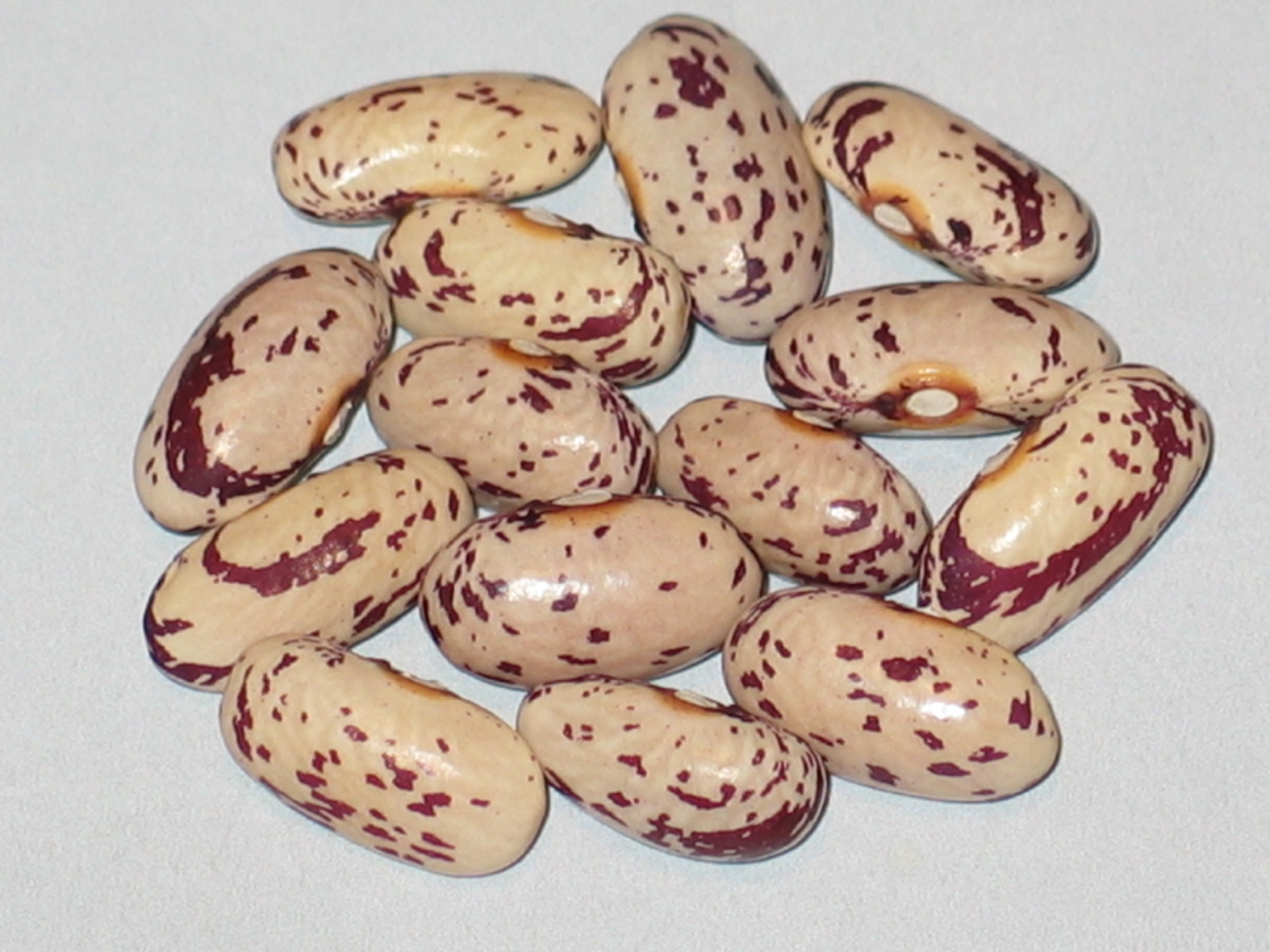
Emelia's Italian
Packet Size 30 Seeds $5.00
Emelia's Italian is an early and productive pole snap bean, celebrated for its heritage and history. Named after Mrs. Emelia Fuller, who brought the seeds from St. Pietro in Udine, Northern Italy, to Nanaimo, British Columbia, in 1911, this variety was initially marketed as "Auntie Vi’s." Annette Barley also of Nanaimo, later advocated for the name change to honor Emelia. Annette, who shared the seeds with me in 2016, emphasized that she has always used this bean as a snap variety, showcasing its culinary versatility and cultural significance.

Empress
Packet Size 10 Seeds $5.00
Empress is a pole lima bean variety known for its large beans and impressive growing timeline, taking 116 days to produce the first dry pods, with the remaining harvest completed within 30 days. Sourced from the lima bean collection of Curt Burroughs in Memphis, Missouri, there is speculation that it may be an outcross of the Christmas variety. Notably, the Empress grew consistently true to type in my experience, highlighting its reliability for cultivation.

Ernie's Big eye
Packet Size 20 Seeds $5.00
Ernie's Big Eye is a bush dry bean variety originally developed by the late Ernest B. Dana from Etna, New Hampshire, and has its roots in the late 1970s within John Withee's Wanigan bean network. This bean features a seed coat color pattern similar to Jacob's Cattle, which Ernie particularly admired. Its unique characteristic includes being soil sensitive; when grown in my soil, the beans predominantly exhibit a red color with only a touch of white, though the seed appearance may vary in different soil conditions.

Evening Moon
Packet Size 25 Seeds $5.00
Evening Moon is a semi-runner dry bean variety that I discovered in my garden around 1981 and named. Upon harvesting, the seeds display a light flesh tone, which remains relatively consistent in color for several years. This distinctive characteristic contributes to its uniqueness among bean varieties.
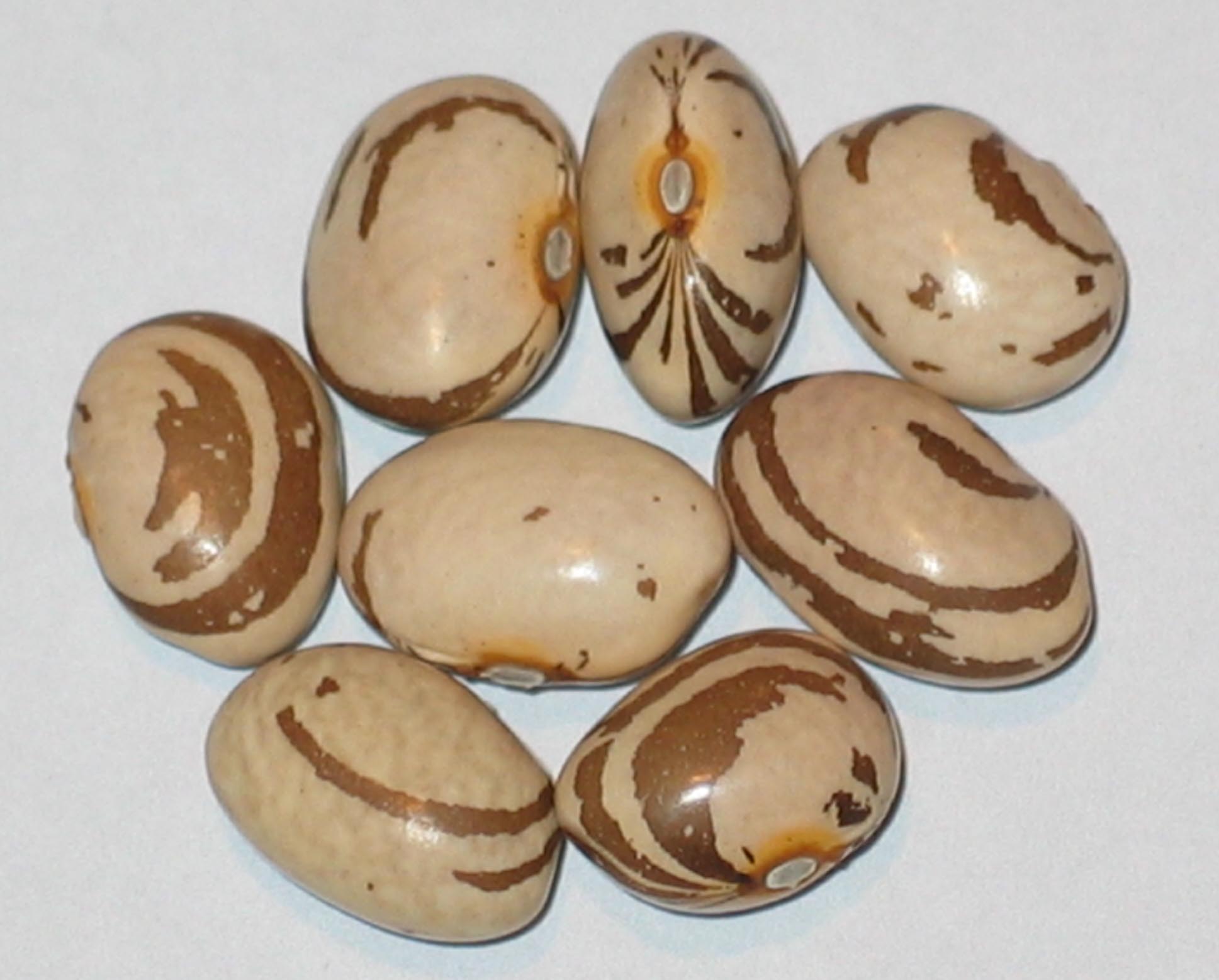
Eye Of The Goat
Packet Size 20 Seeds $5.00
Pole/Dry. Begins maturing dry seed in about 90 to 100 days. Eye of the Goat is a traditional heirloom bean variety, often recognized for its unique seed markings that resemble a goat's eye. It is known by various names, including "Bishop's Minuette" and "Goat's Eye Bean." It has roots in several cultures, among Indigenous communities in the Americas, where it has been cultivated for centuries due to its resilience and adaptability. The bean is valued not only for its distinct appearance but also for its hearty flavor and nutritional quality, making it a cherished choice for both home gardeners and culinary enthusiasts alike.
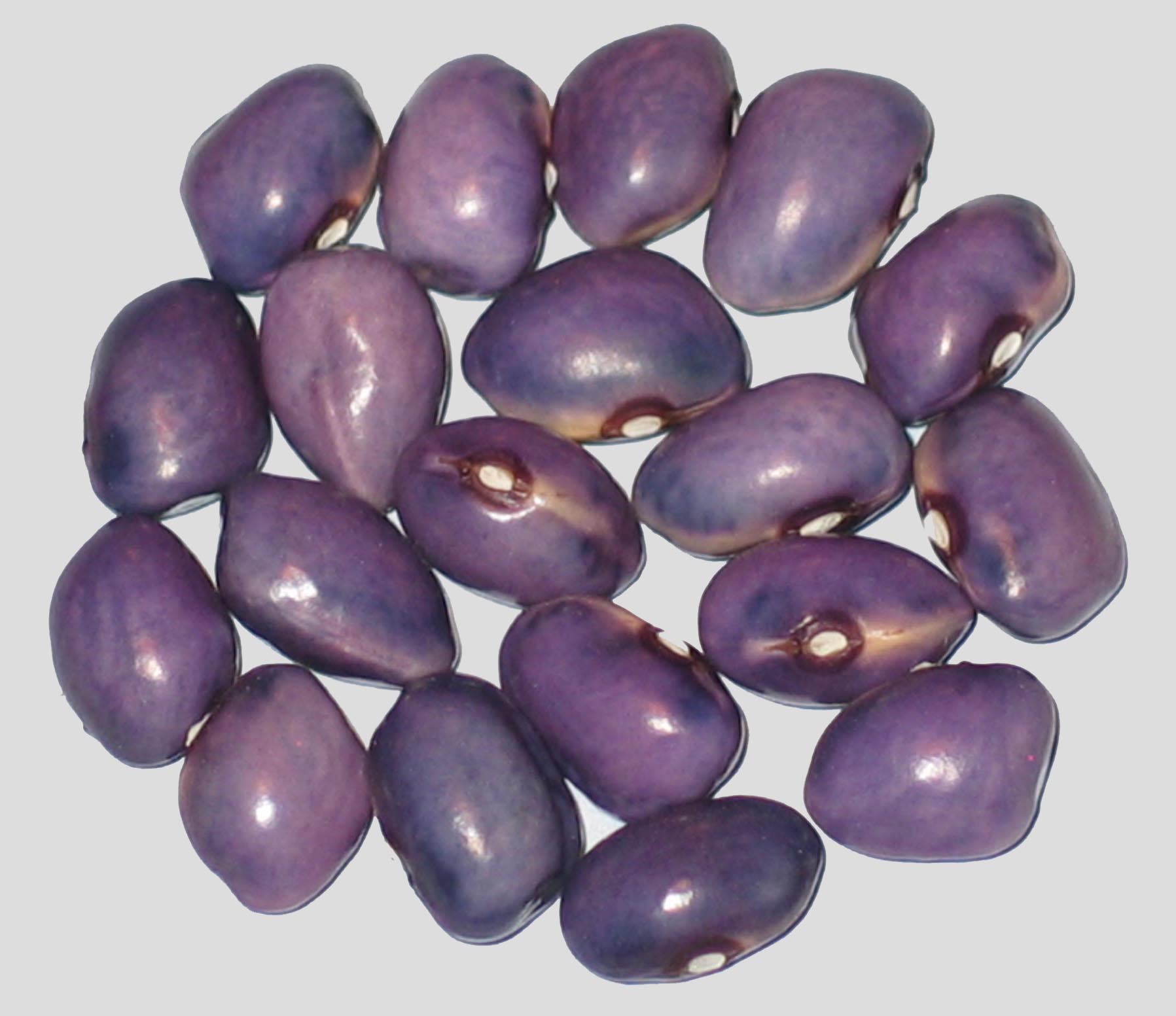
Fagiolo Viola Di Assiago
Packet Size 20 Seeds $5.00
Pole dry. Viola Di Assiago cultivated by the Cimbrian populations living in the area of Roana, Mezzaselva and Rotzo on the Asiago plateau in Northern Italy. This bean had been replaced by other varieties, it was now intended for self-consumption. Today it is at the center of an agricultural project. Gastone Azzolini and six other producers, inhabitants of the plateau, decided in 2016 to give new life to Viola Di Assiago. Planting takes place between the end of April and the begining of May. Towards September the first fresh beans are ready. Their flavor is excellent and particular, so much so that some starred chefs have chosen them to compose their dishes.

Falcon
Packet Size 60 Seeds $5.00
Semi Runner Dry. Dry seed in about 90 days. These are the tiniest bean seeds I have ever grown. Falcon is an heirloom variety with roots in the Southwestern United States. Known for its drought tolerance and adaptability to the arid conditions of the region, The Falcon bean has been valued by farmers and gardeners for its robust flavor and culinary versatility. It reflects the agricultural heritage of the area.
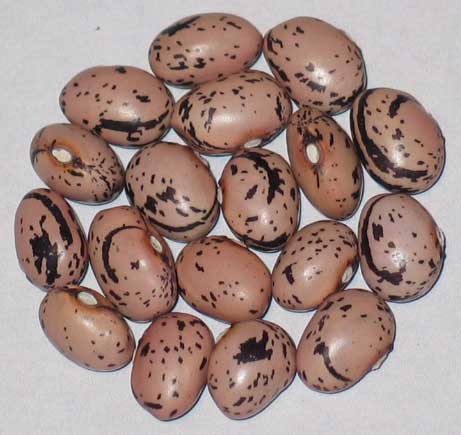
Falsetti
Packet Size 25 Seeds $5.00
Pole/Dry. The Falsetti bean is a historic heirloom variety known for its distinctive pale pink seeds adorned with black or dark gray speckles. Originating from Serra Aiella in the Consenza province of Calabria, Italy, this pole bean was brought to the United States in the 1940s by Gaetano Falsetti, who preserved its cultural significance and culinary heritage. Recognized for its productivity and adaptability, the Falsetti bean has become cherished among gardeners and chefs, especially for its ability to thrive in various growing conditions and its flavorful contributions to a range of dishes, thereby linking Italian and American agricultural traditions.

Fasold
Packet Size 30 Seeds $5.00
Pole/Snap. Fasold is of European origins, specifically linked to Germany. This productive heirloom variety is early and known for its long, tender pods that are ideal for fresh consumption and are often prized for their rich flavor and crisp texture. It is noteworthy that Fasold is a giant found in classical German Heroic literature, also an opera of Wagner. Possibly someone named the bean after Fasold the Giant. Fasold is reflective of a long tradition of vegetable cultivation in Europe. As with many heirloom beans, it has been preserved by seed savers enhancing its popularity in organic and home gardening. It's adaptability and quality are celebrated.
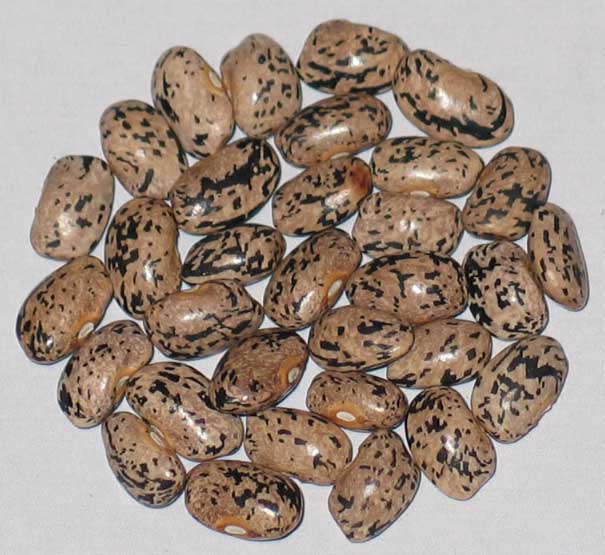
Faulkner’s Cornfield
Packet Size 30 Seeds $5.00
Pole/Dry. Faulkner's Cornfield is a vigorous pole bean variety recognized for its productivity, producing an abundance of pods with seeds that are often crowd together, resulting in uniquely flattened seed ends rather than the typical rounded shape. The bean provides a rich harvest of flavorful dried beans known for their culinary versatility. An heirloom bean variety that originates from the agricultural traditions of the American South, particularly tied to the region's history of subsistence farming. These beans are characterized by their small, mottled appearance, often showcasing colors ranging from brown to cream,

Flor De Junio
Packet Size 25 Seeds $5.00
Pole/Dry. Flor de Junio, translating to "June Flower," is a pole variety of dry bean that was embraced for its rich culinary potential, especially in Mexican cuisine. Originally sourced from a market in Guadalajara, Mexico, these beans produce 4 to 5-inch pods containing up to 7 beans each, making them both productive and flavorful. They are particularly well-suited for traditional dishes like Frijoles Charros, where their creamy texture enhances the meal. Additionally, they can be mashed into a smooth consistency, perfect for serving with salsa or as a savory bean dip, showcasing their versatility in various recipes.

Florida Speckled
Packet Size 20 Seeds $5.00
Florida Speckled is a vigorous pole lima bean variety, well-suited for warm climates, boasting a remarkable tolerance to both heat and humidity. Typically maturing in about 100 days to the first dry pods, it features heavy-producing vines that thrive in southern conditions, making it an excellent choice for gardeners in Illinois as well. This variety, believed to be over 400 years old, is revered for its historical resilience and culinary quality, particularly favored for its creamy texture and flavor, making it a staple in Southern cuisine. Its robust growth and adaptability reinforce its status as one of the premier lima or butterbean varieties in warmer regions.
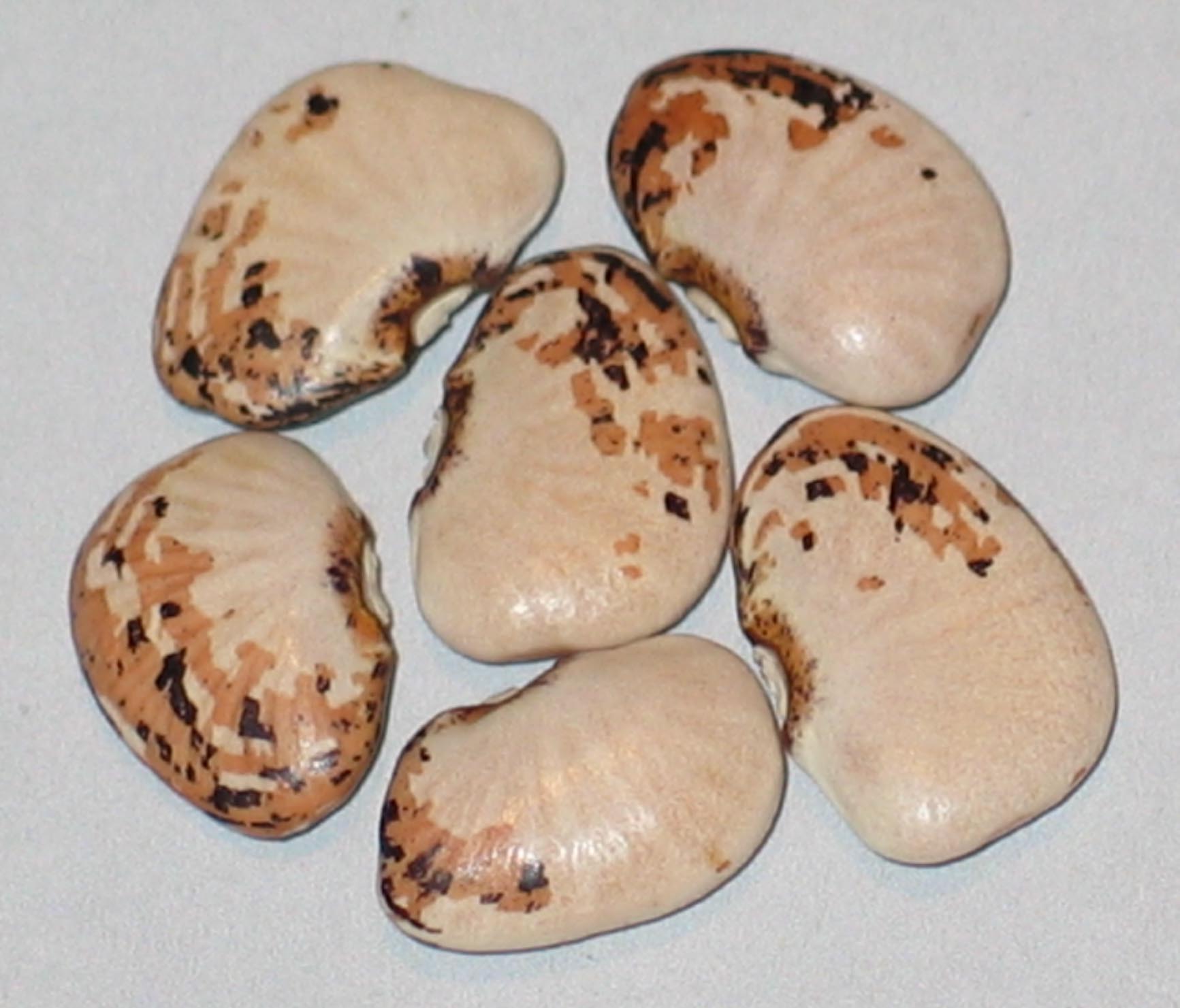
Flossie Powell
SOLD OUT
Flossie Powell is a highly productive pole lima bean variety known for its exceptional yield, as evidenced by a planting of just four seeds that produced over a pound of beans in one grow out. A resilient variety reliably matures its entire crop before the first killing frosts, making it an excellent choice for shorter growing seasons. Introduced to the Seed Savers Exchange in the 1980s by Harold R. Martin from Hopkinsville, KY, Flossie Powell's lineage traces back to Ethel Martin, who originally received the seeds from Flossie Powell in 1922. Its rich history and reliable performance make it prized among home gardeners and bean enthusiasts alike.

Forelle Fliederfarben
Packet Size 25 Seeds $5.00
Forelle Fleiderfarben is a productive pole dry bean variety known for its rounded shape and unique color traits, which can sometimes lean towards gray depending on soil conditions. This bean, originally acquired from a grower in Austria, has a striking appearance similar to the U.K. variety known as Cranberry Lilac. Its robust growth and adaptability make it a valuable addition to any garden, especially for those seeking a unique and flavorful dry bean option with European origins.
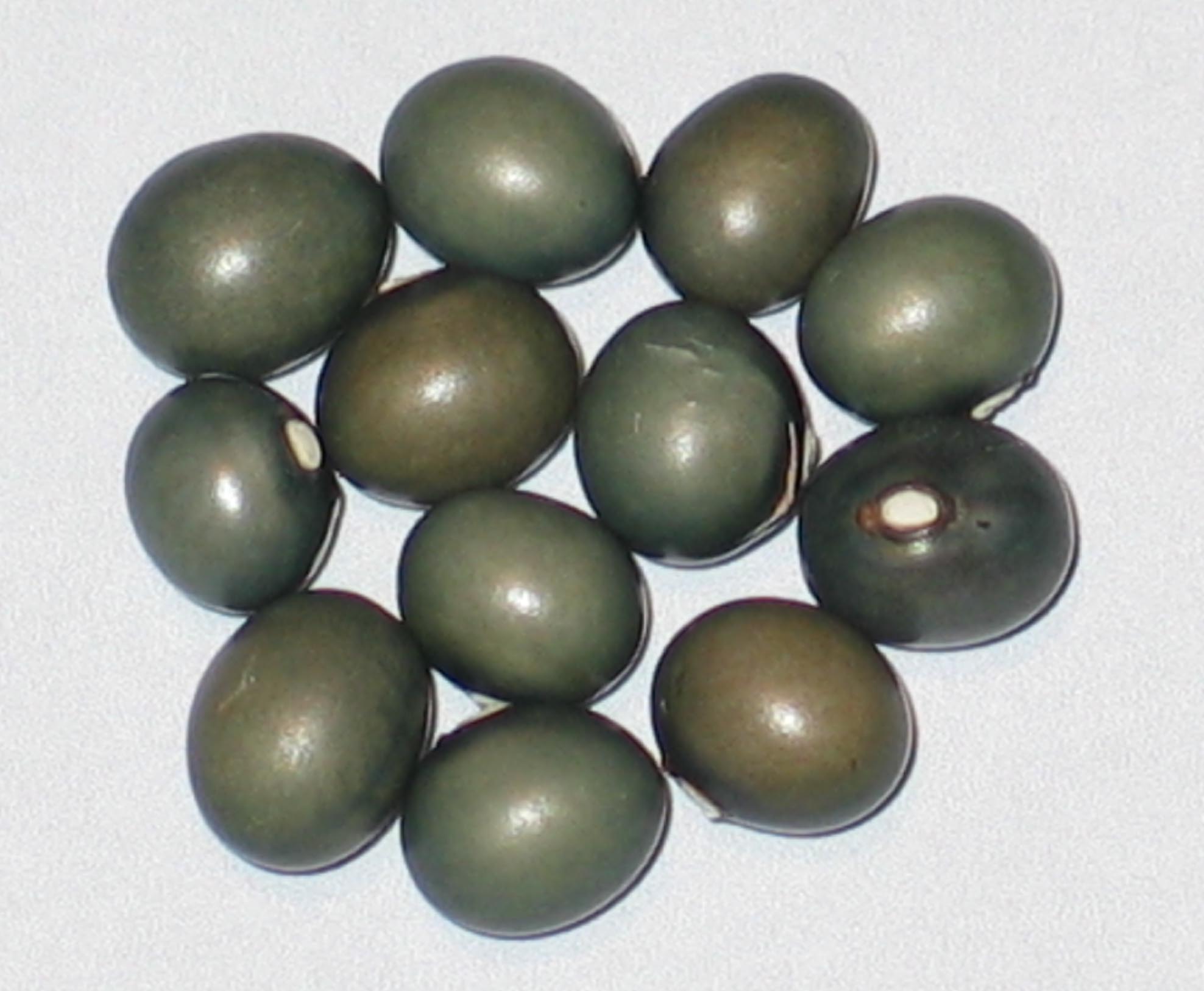
Fort Portal Jade
SOLD OUT
Fort Portal Jade is a semi-runner dry bean with a striking bluish-green hue, sourced from a gardener in Groningen, Netherlands, who acquired it from a grower in Belgium. Its origins trace back to Fort Portal, Uganda, where it was originally discovered by American seed collector Joseph Simcox. Locally, the people in Uganda referred to this variety simply as "a bean," indicating its commonplace nature in their agriculture. This unique bean not only stands out for its coloration but also carries with it a rich history of cultural exchange and seed preservation across different regions.

Freckles
Packet Size 25 Seeds $5.00
Freckles is a bush dry bean variety that takes approximately 85 days to produce its first dry seeds. These seeds are smaller than those of the Jacobs Cattle bean and share a similar pattern, with a greater proportion of white space on the seed. The distinctive feature of Freckles is its fine red spots that are scattered across the white background, creating an attractive appearance.
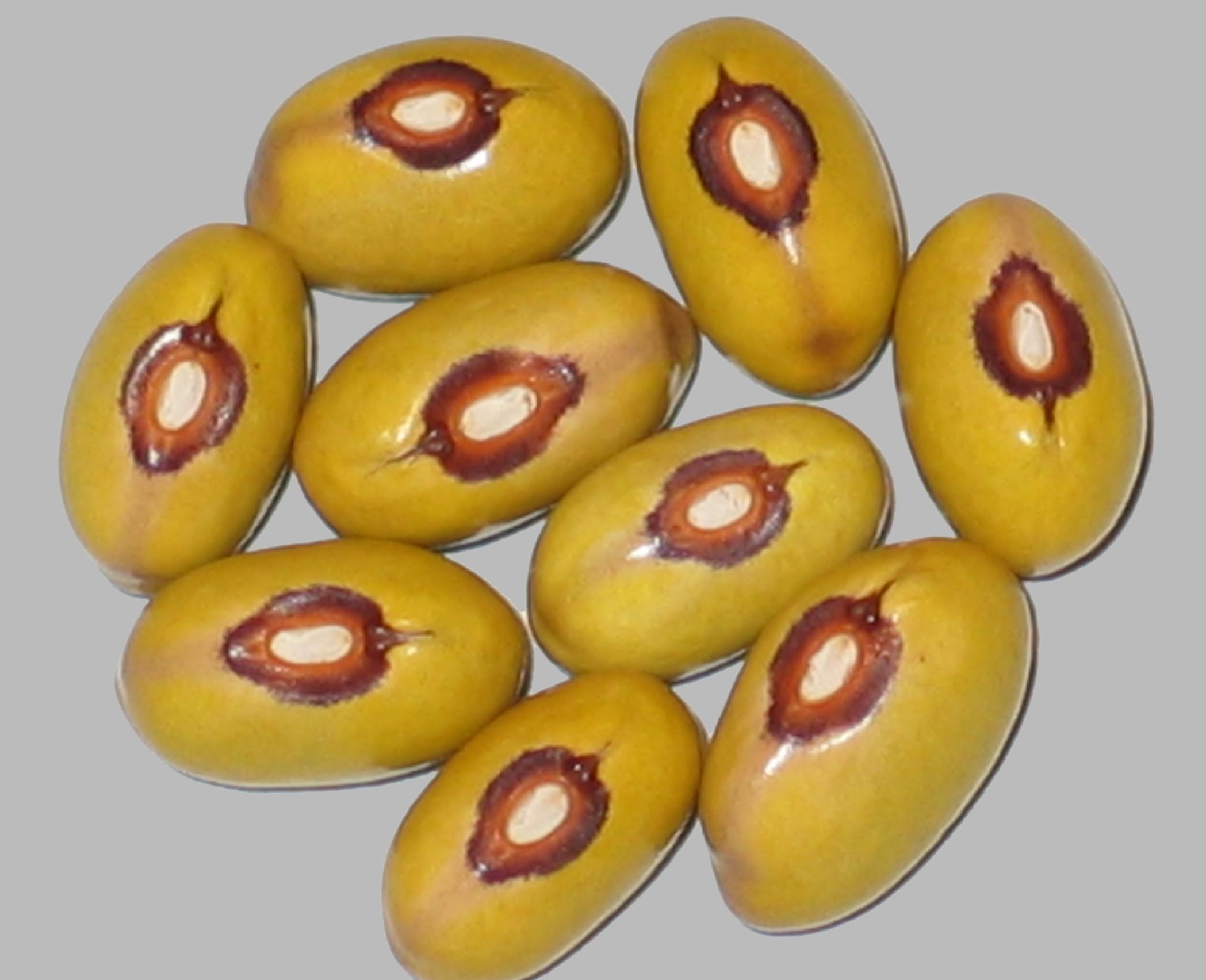
Fruhe Goldbohne
Sold Out
Fruhe Goldbohne, translating to "Early Gold Bean" in German, is a bush dry bean variety featuring compact 12-inch tall plants that produce 4.5-inch green pods. The eye-catching yellow beans, adorned with a brownish eye ring, have a striking and almost luminous appearance, making them a standout in any garden. Sourced from a bean trading friend in Austria, this variety not only boasts aesthetic appeal but also brings a rich cultural heritage and culinary potential, perfect for those interested in growing unique heirloom beans.
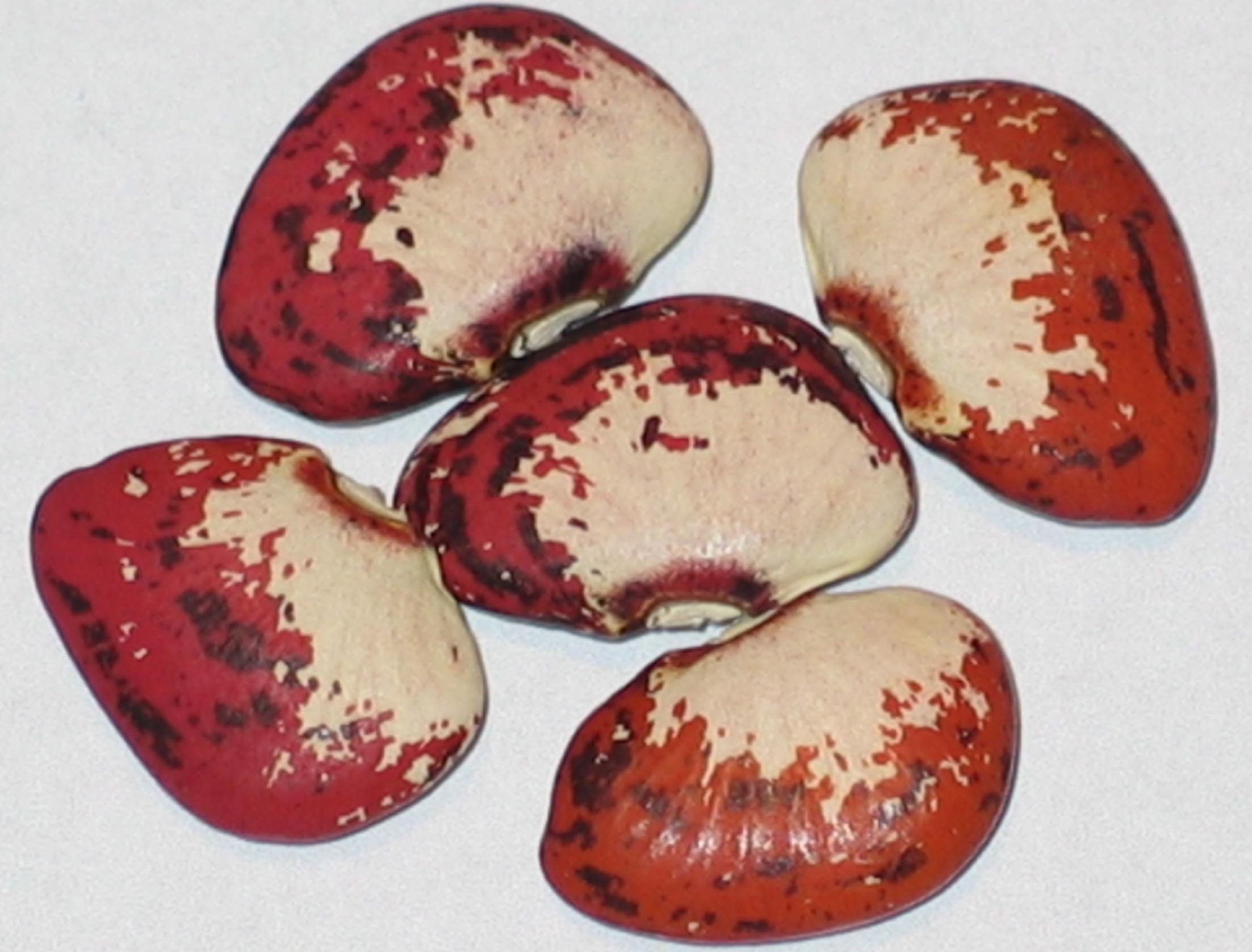
Ganymede
Packet Size 20 Seeds $5.00
Ganymede is a pole lima bean variety known for its vigorous growth and productivity, requiring over 100 dry days to mature. Tracing its origins back to the early 1980s, this bean was initially received from an unlisted SSE member, E.P. Griggs, who had no name for it. Inspired by images of Jupiter and its moon system from National Geographic, I named this bean after Ganymede, one of Jupiter’s moons, and after over 40 years, the name has certainly become established. This variety is a great choice for gardeners seeking a robust and fruitful addition to their bean collection.

Ga Ga Hut
Packet Size 25 Seeds $5.00
Ga Ga Hut is a pole drt bean variety known for its short climbing habit, reaching about six feet, and its impressive productivity. In northern Illinois summers, it matures quickly, with the first dry pods ready in approximately 80 days, followed by a second, smaller flush of quality dry seeds in an additional 40 days. This variety is a Native American version of a pinto bean, making it not only a fruitful choice for home gardeners but also a connection to cultural heritage and traditional agriculture practices.

Genesis
Sold Out
Genesis is a pole lima bean variety sourced from the collection of Curt Burroughs in Memphis, Missouri, who obtained it from the USDA seed bank in Pullman, Washington. Limited information about this bean is available from the seed bank, but it demonstrated resilience and good growth during in northern Illinois summers, even with some partial shading. Its full potential and performance is a fully sunlit environment. It's black and white strinkingly marked seeds make it an intriguing option for gardeners interested in experimenting with lesser-known varieties.
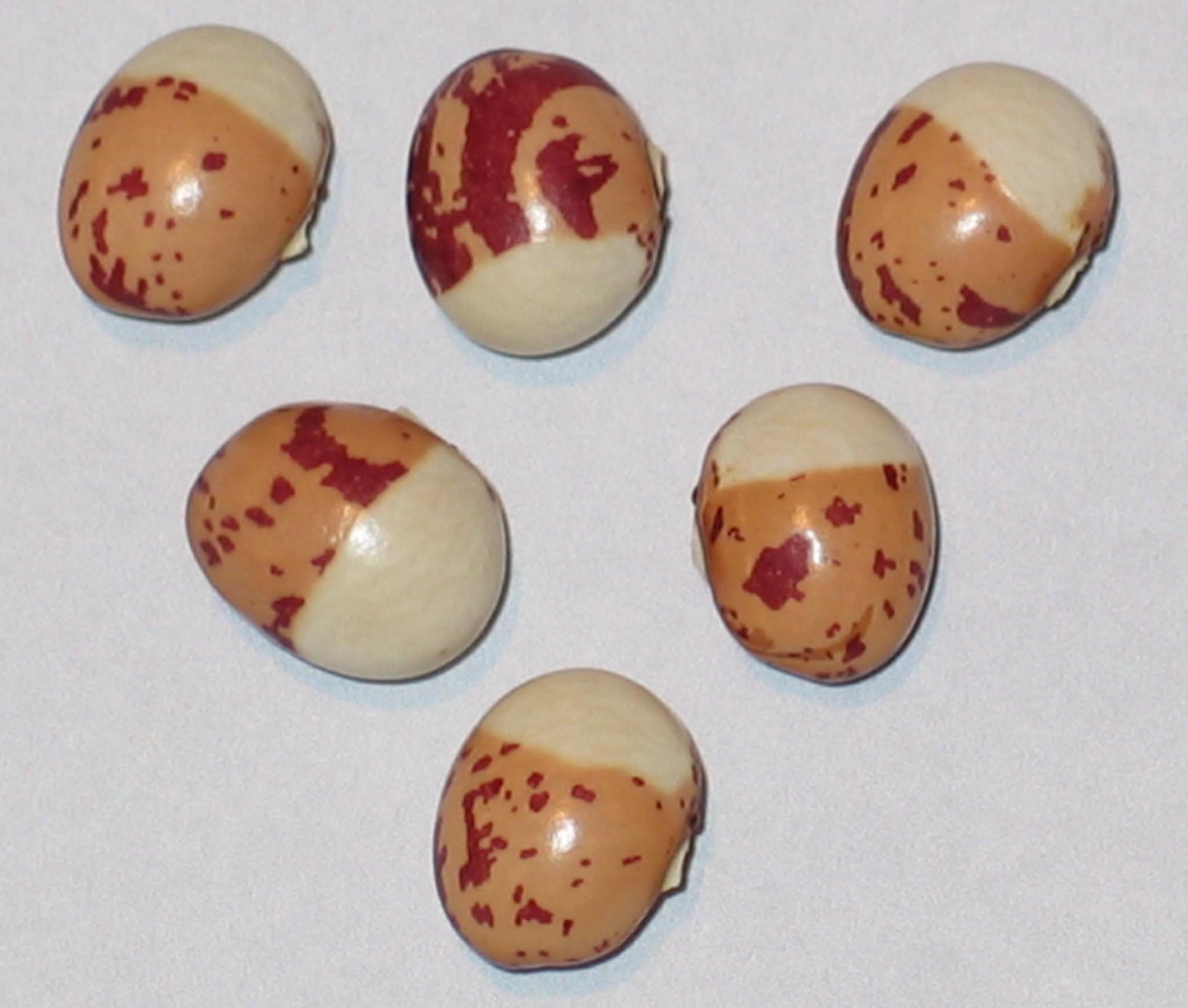
George's Bean
Packet Size 25 Seeds $5.00
George's Bean is a pole dry bean variety with roots in England, traditionally used for baked beans. It was sourced in the winter of 2013 by Harriet Mella from Deaflora Seeds in Germany, highlighting its international heritage. Known for its robust growth and culinary applications, this heirloom variety offers gardeners a chance to cultivate a piece of history while enjoying its potential in various dishes, particularly in baked bean recipes.
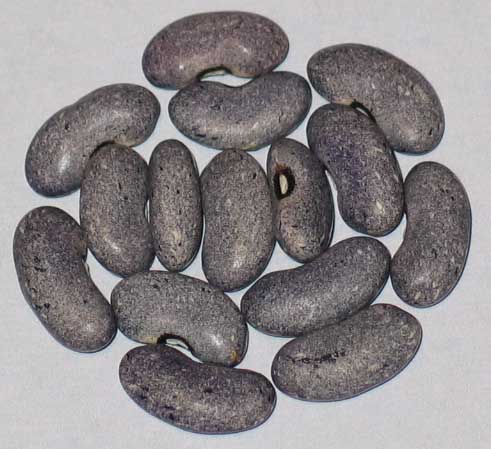
Giant Nilgiri
Packet Size 20 Seeds $5.00
Giant Nilgiri is a pole dry bean variety known for its large size, with beans measuring about three-quarters of an inch long. This heirloom variety originates from the Nilgiri Mountains, a picturesque region spanning the Indian states of Tamil Nadu, Karnataka, and Kerala, often referred to as the Blue Mountains. The region's unique climate and elevation contribute to the distinct characteristics of these beans, making them a sought-after choice for growers and culinary enthusiasts alike. They are celebrated for their flavor and potential uses in various dishes, particularly in traditional Indian cuisine.

Giant Stringless Greenpod
SOLD OUT - To Be Regrown In 2025
Giant Stringless Greenpod is a bush snap bean variety characterized by its tall plants, reaching over two feet in height, and its long, stringless pods, which have some variability in length. Developed by Calvin Keeney, heralded as the father of the stringless bean, this variety gained prominence in the early twentieth century after being introduced by Johnson & Stokes Seed Company in 1898. Highly regarded for its ease of harvest and flavor, it remains a favorite among gardeners and is often celebrated for its contributions to the evolution of snap beans.
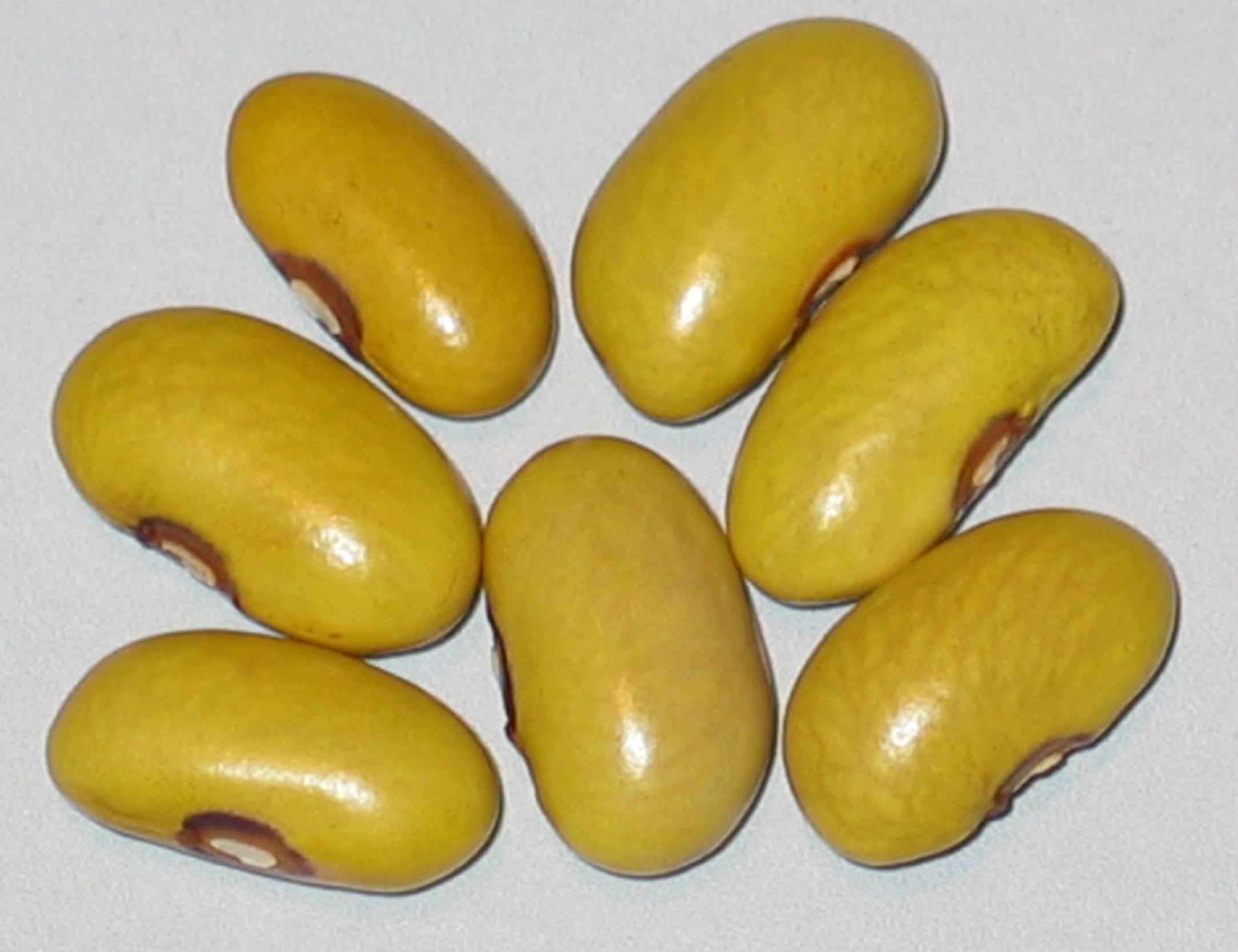
Giele Waldbeantsje
Packet Size 25 Seeds $5.00
Giele Waldbeantsje, also known as "Yellow Forest Bean," is a traditional heirloom dry bean variety that hails from the Netherlands, specifically associated with the region of Giele in Friesland. These beans are characterized by their striking yellow seeds and can be used as snap beans when harvested young. Known for their robust flavor and tender texture, they are often grown in home gardens and are appreciated for their resilience and productivity. Giele Waldbeantsje is valued not only for its culinary uses but also for its connection to cultural heritage, preserving the agricultural practices of past generations.
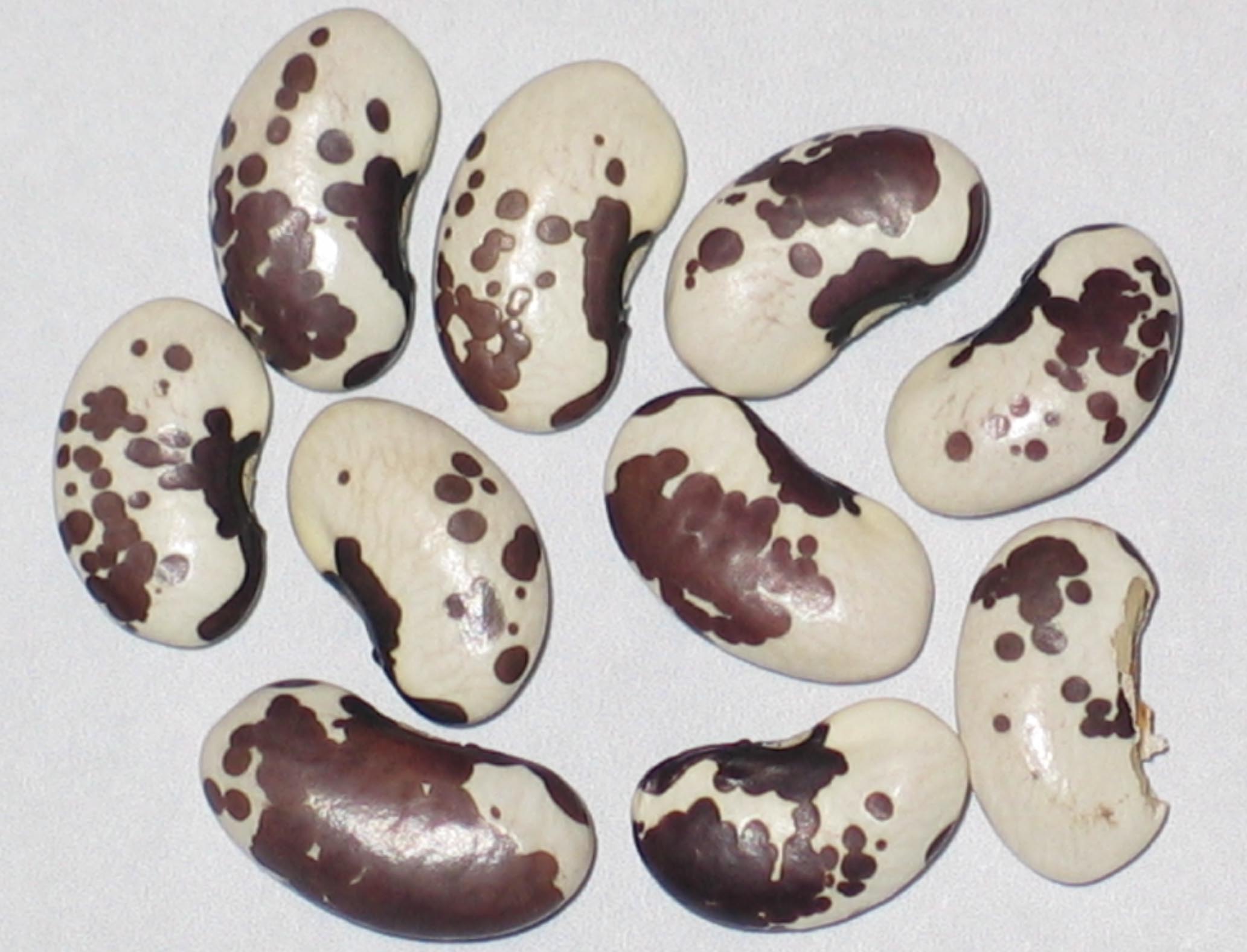
Gila River
Packet Size 25 Seeds $5.00
Gila River is a pole dry bean variety that takes over 100 days to mature dry seed. Legend has it that this bean was discovered at a Native American archaeological site along the Gila River in the Southwest USA, where seeds were found in a pottery jar sealed with pine sap, dating back 1,500 years. The preservation conditions of consistent temperature and humidity allowed the seeds to remain viable over the centuries, making it a fascinating example of ancient agricultural practices and a significant link to Native American heritage. If true, this story underscores the resilience of traditional crops and their importance in sustaining cultural history.
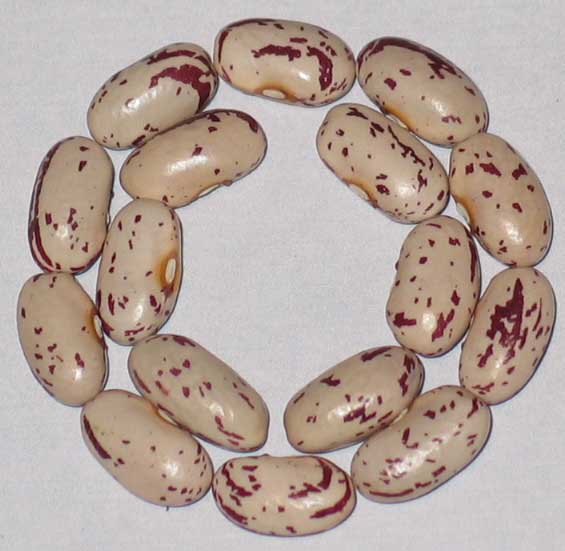
Gillenwater
Packet Size 25 Seeds $5.00
Gillenwater is a semi-runner dry bean variety known for its productivity and slightly later maturation, typically taking around 100 days to produce its first dry pods. This West Virginia heirloom features seed coat colors and patterns similar to many horticultural beans, making it visually appealing as well. Its heritage reflects the agricultural traditions of the region, and it is valued by gardeners for its resilience and flavor, contributing to the diversity of heirloom beans cultivated today.

Gill's Delicious Giant
Packet Size 25 Seeds $5.00
Gill's Delicious Giant, also known as Delicious Giant, is a pole snap bean variety introduced by the Gill Brothers Seed Company in 1925. A cross between Oregon Giant and Kentucky Wonder, matures in about 70 days for snaps and 100 days for dry seeds. It is distinguished by its unusual pod size and pod clusters, featuring longer and more slender pods compared to Oregon Giant. Its early maturity and prolific growth make it a popular choice among gardeners, appreciated for both its yield and taste.
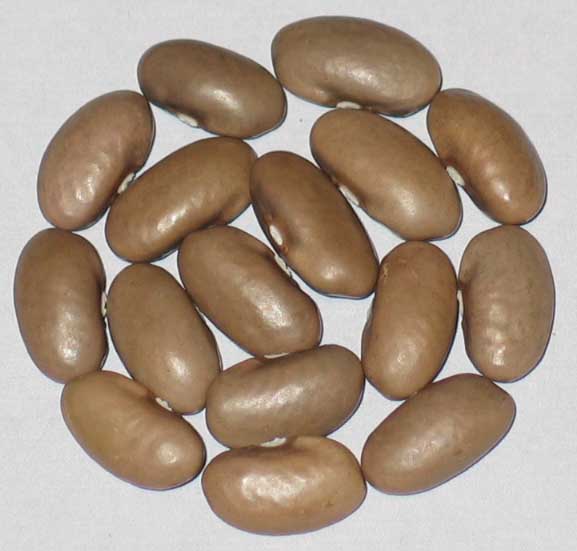
Gold Of Bacau
Packet Size 25 Seeds $5.00
Gold of Bacau is a Romanian pole snap bean variety known for its prolific production of flattened yellow pods measuring 6 to 10 inches in length. Renowned for its sweet flavor and crunchy texture, this variety stands out as its pods remain stringless and tender on the vine longer than many others. Pickable snaps can typically be harvested in about 60 to 70 days, and the seeds are versatile, suitable for use in soups or baked beans, making it a valuable addition to both gardens and kitchens.
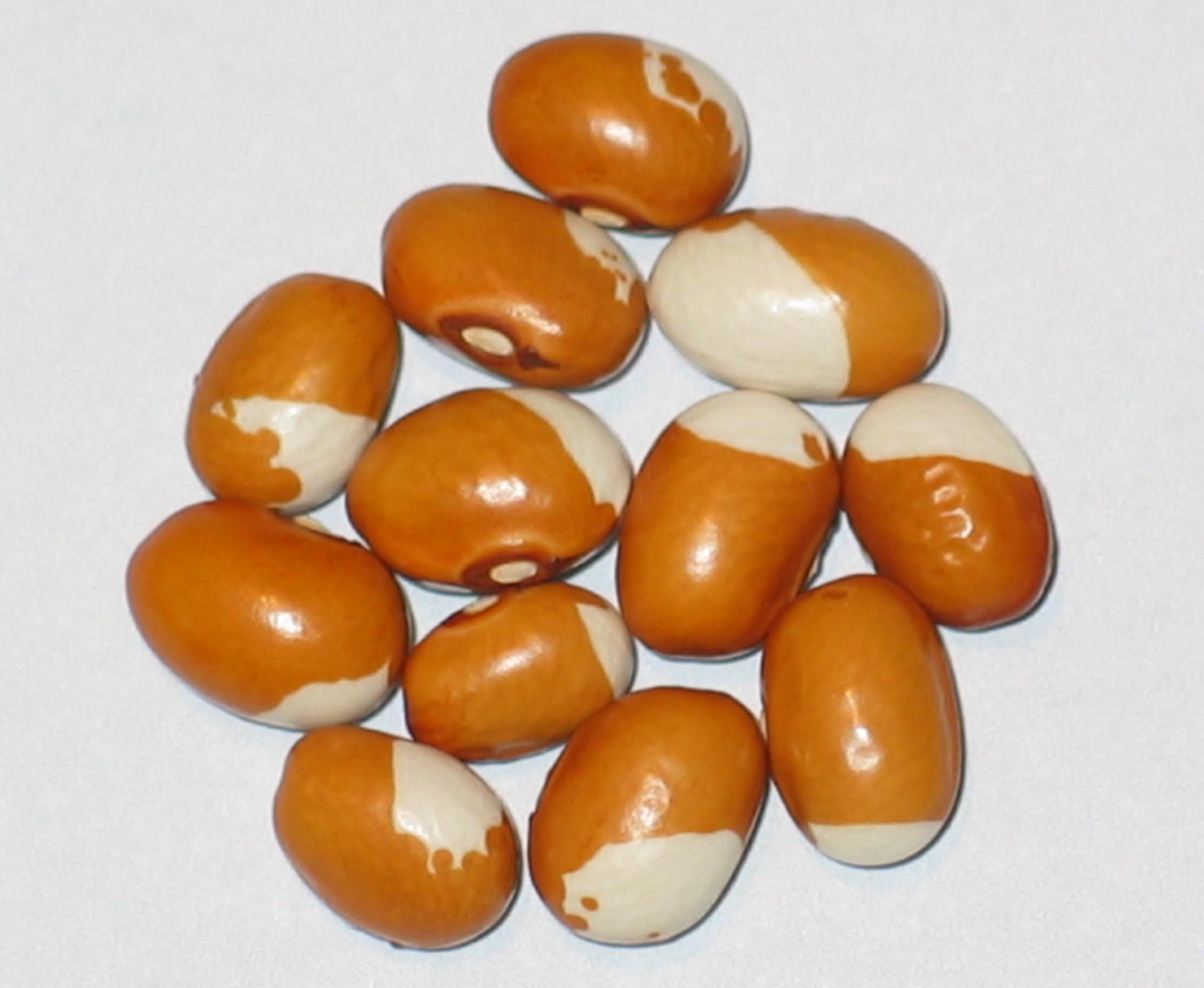
Goldener Regen
Packet Size 30 Seeds $5.00
Goldener Regen, which translates to "Golden Rain" in English, is a pole dry bean variety sourced for me by Harriet Mella of Austria from Deaflora seeds in Germany during the winter of 2013. Productive plants are notable for their visually appealing golden yellow and white seeds, adding aesthetic value to any garden. Its unique characteristics make it an interesting addition for bean enthusiasts and offer potential for culinary versatility.

Golden Bear Lake
Pakect Size 25 Seeds $5.00
Bush/Dry. About 85 days to begining of dry pods then the remainder of it's pods dry sequentially over about 3 weeks. Very productive light toned beans of good quality when harvested new are nearly white. Seeds take months to develop their color and pattern. If frozen the color devekopment will stop. This bean developed from the Robert Lobitz legacy material I had obtained in 2015 from a former member of the Seed Savers Exchange Ron Thuma of Hartford Kansas. I had considered the bean stable and ready to be named in 2021.

Golden Lima
Packet Size 25 Seeds $5.00
Golden Lima is a pole dry bean variety that takes 90 or more days to produce dry seeds. Despite its name, it is not a true lima bean; rather, its flattened seeds give it a similar appearance. This unique characteristic, along with its longer growing season, makes Golden Lima a distinctive option for gardeners looking to experiment with different bean varieties.
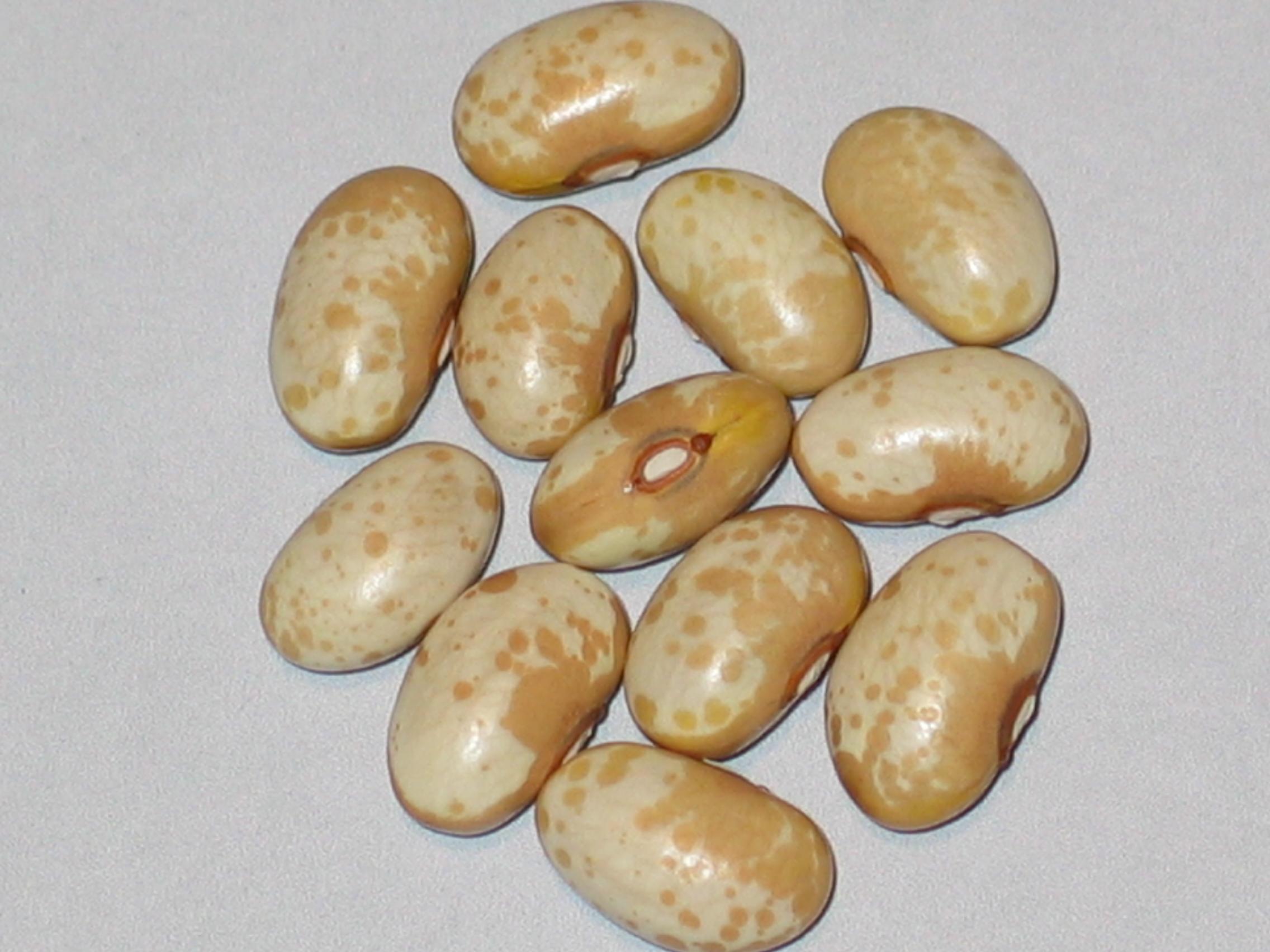
Golden Valley
Packet Size 25 Seeds $5.00
Golden Valley is a bush dry bean variety introduced by Robert Lobitz, a member of the Seed Savers Exchange in Decorah, Iowa, who first released it to the public in the early 2000s through the Seed Savers Exchange yearbook. With a growth period of approximately 85 days to first dry pods, these productive plants reach about 18 inches in height and yield solid green pods averaging 6 inches in length, each containing about 5 seeds. This variety offers both efficiency and ease of cultivation for gardeners.
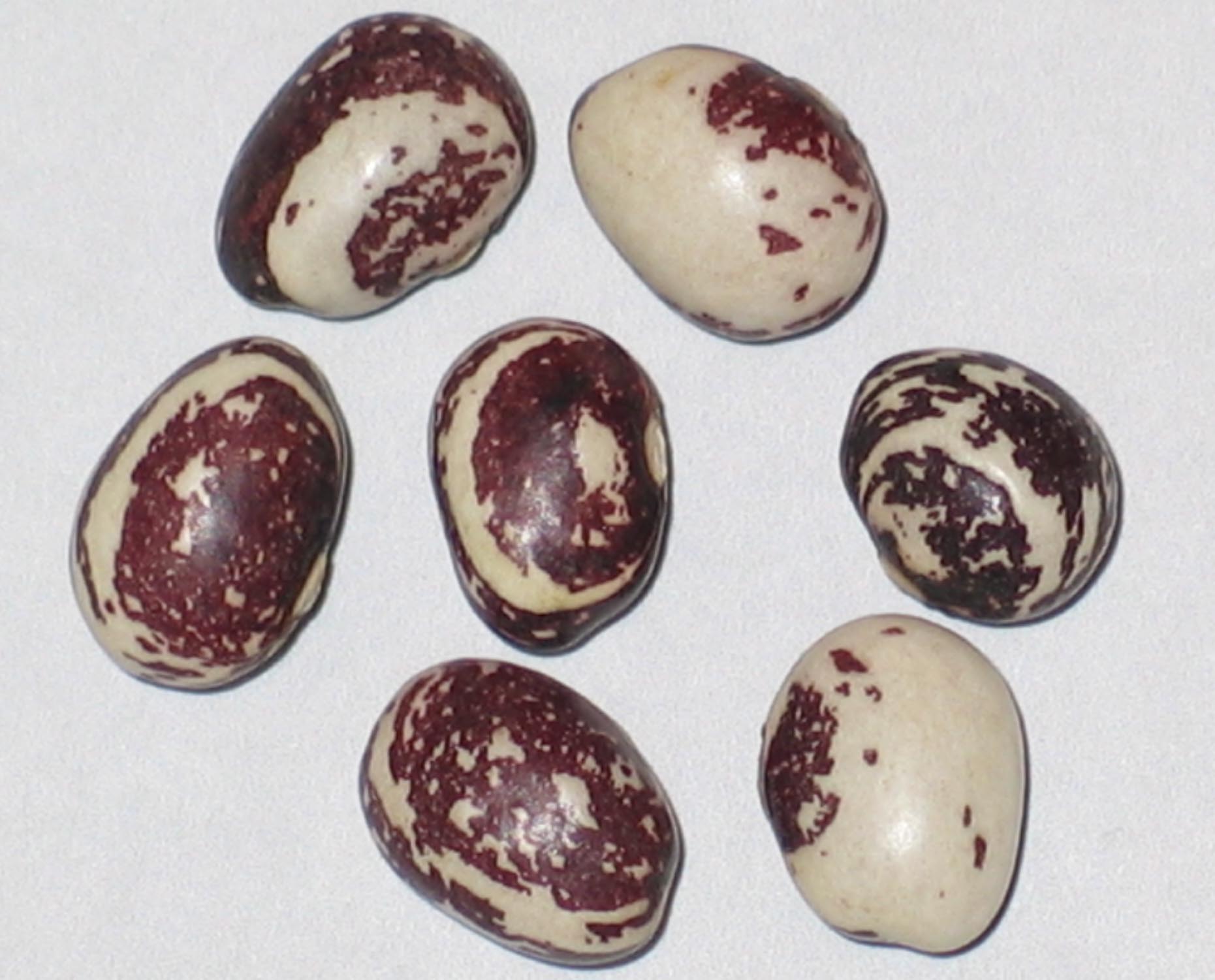
Good Mother Stallard
Packet Size 30 Seeds $5.00
Good Mother Stallard is a pole dry heirloom bean that takes over 95 days to produce dry seeds and can climb up to 6 feet in height. Known for its attractive seeds and creamy texture when stewed, this variety is also resistant to the BCMV mosaic virus. Tracing back to the 1930s, it was donated to John Withee's Wanigan Associates in the late 1970s or early 1980s, and Withee named it in honor of Carrie Belle Stallard from Wise County, Virginia, making it a cherished choice for gardeners and food enthusiasts alike.
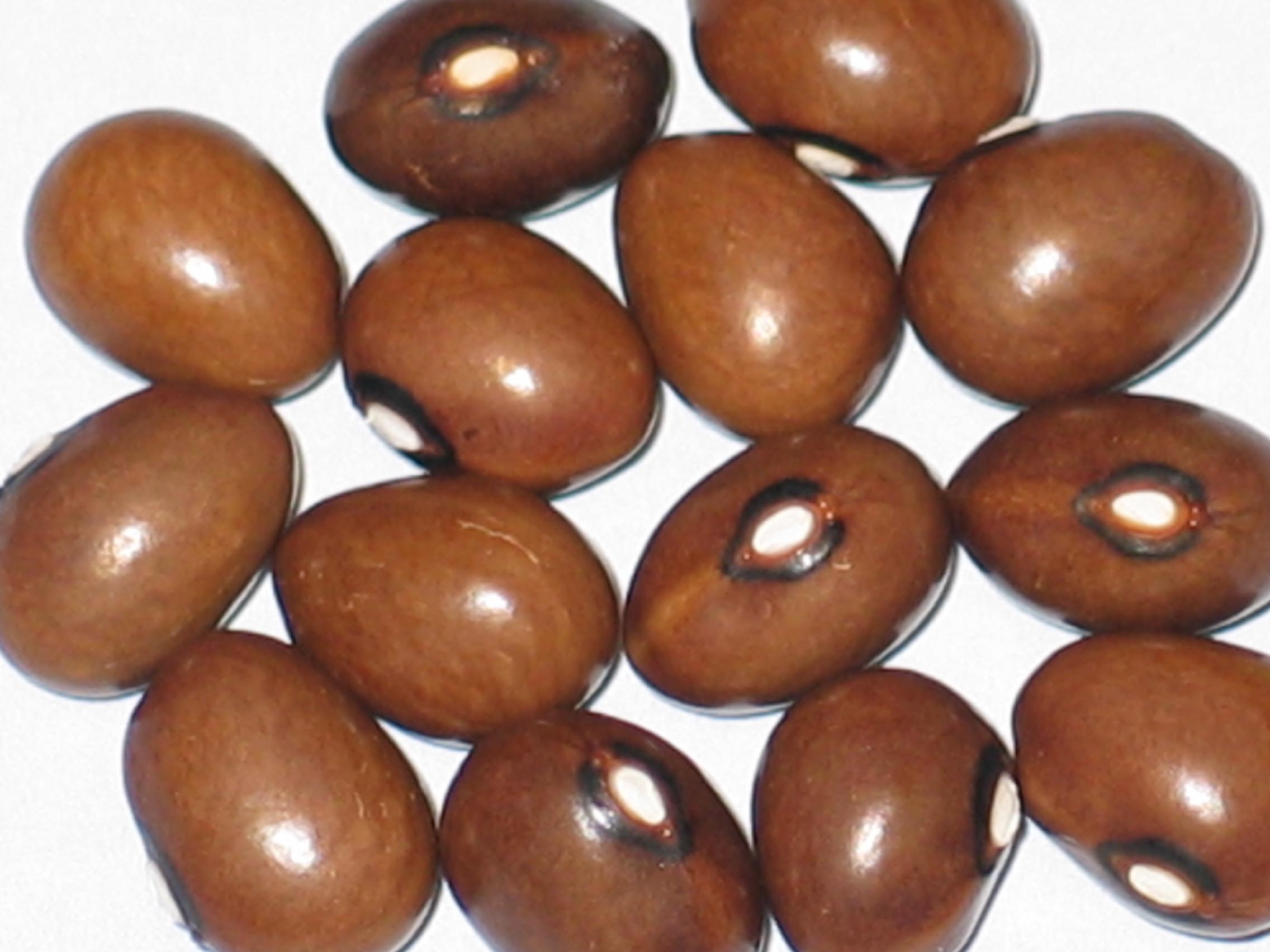
Graines de Cafe
Packet Size 20 Seeds $5.00
Graines de Cafe, which translates to "Coffee Beans" in English, is a pole dry bean variety that was gifted to me by Austrian gardener Harriet Mella. Known for its remarkable productivity, just 8 plants grown in one summer yielded nearly 2 pounds (910 grams) of its beautiful beans. This variety not only delights with its attractive appearance but also offers an impressive harvest potential for gardeners.
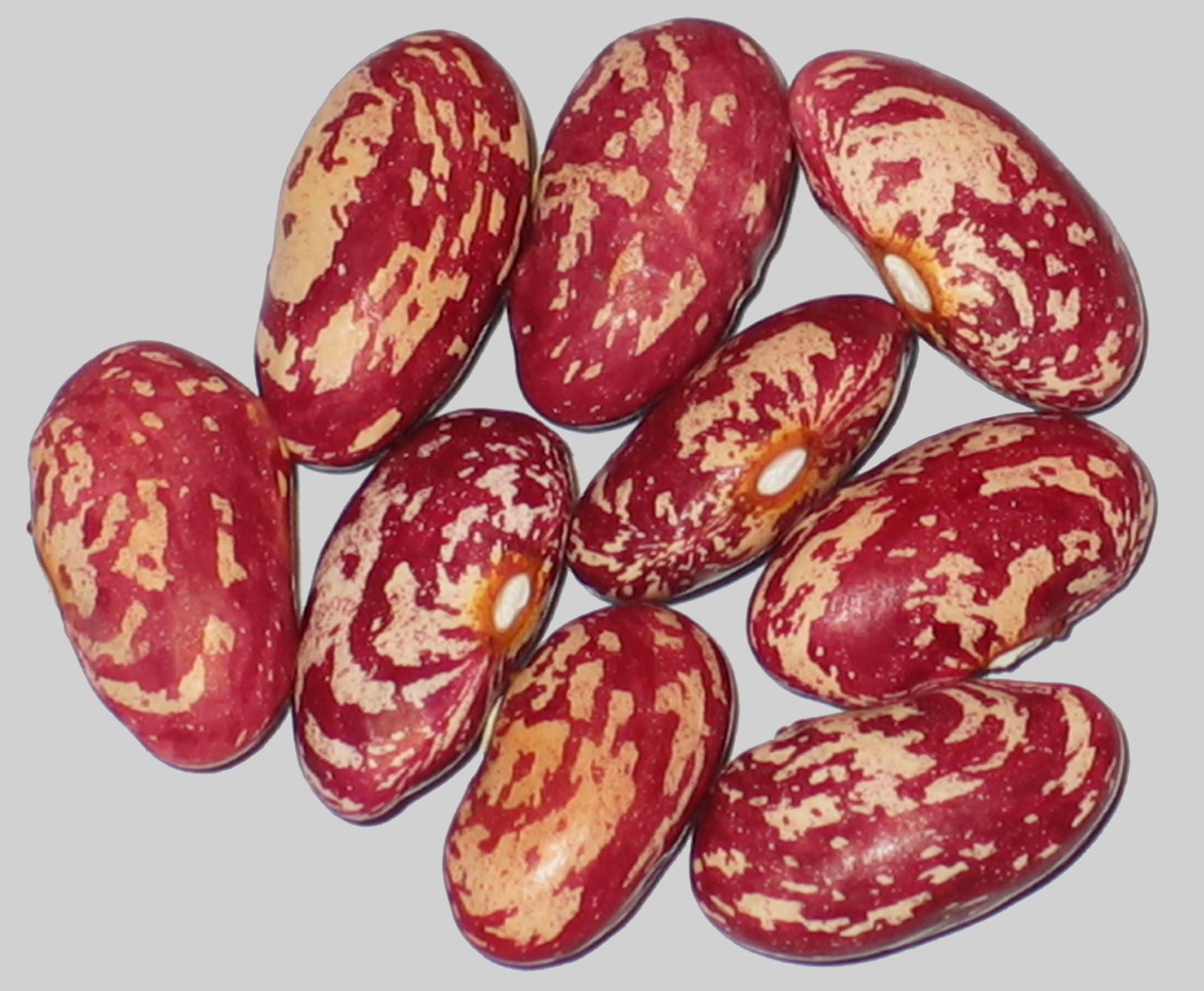
Grandma's Shell
Packet Size 20 Seeds $5.00
Grandma's Shell is a productive bush dry variety of red horticultural bean that grows without runners and features large, plump oval seeds that are dark red mottled with light tan. This bean takes a bit longer to dry pods compared to other early dry bean types, and it gained recognition in the 1970s when John Withee included it in his Wanigan Associates catalog, noting June Bester of Butler, Pennsylvania, as his source. Its performance and distinct appearance make it a favored choice among home gardeners.
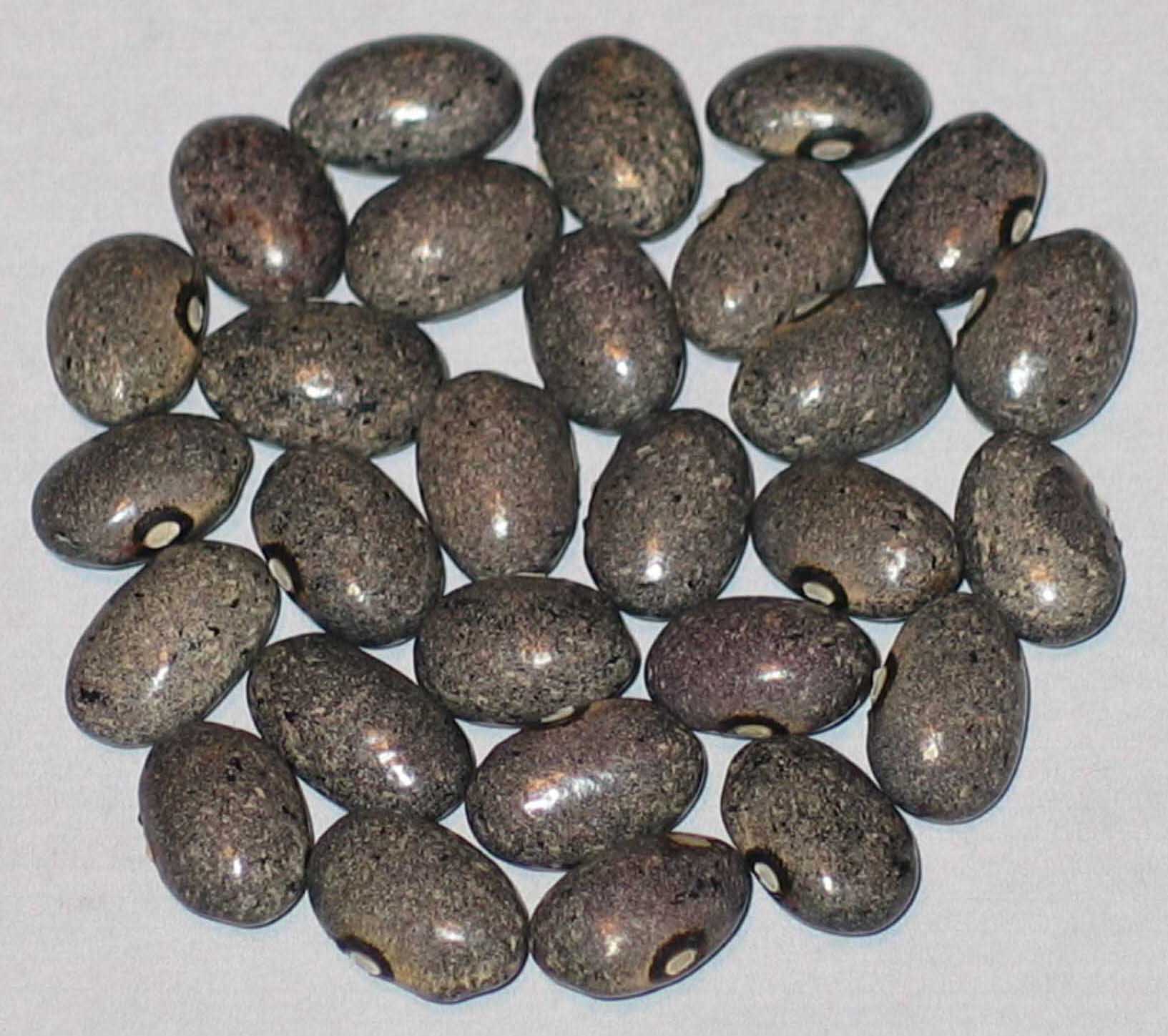
Gray Mountain
Packet Size 20 Seeds $5.00
Gray Mountain is a pole dry bean variety that originated from my 2019 garden, named by me and derives its lineage from a Zebra variety sent by a grower in Pennsylvania. Notably productive, this bean produces an abundance of stunning dark gray seeds that exhibit a fine pebble stone appearance, making them ideal for stewing or baking. The unique characteristics and versatility of Gray Mountain highlight its appeal for culinary uses.
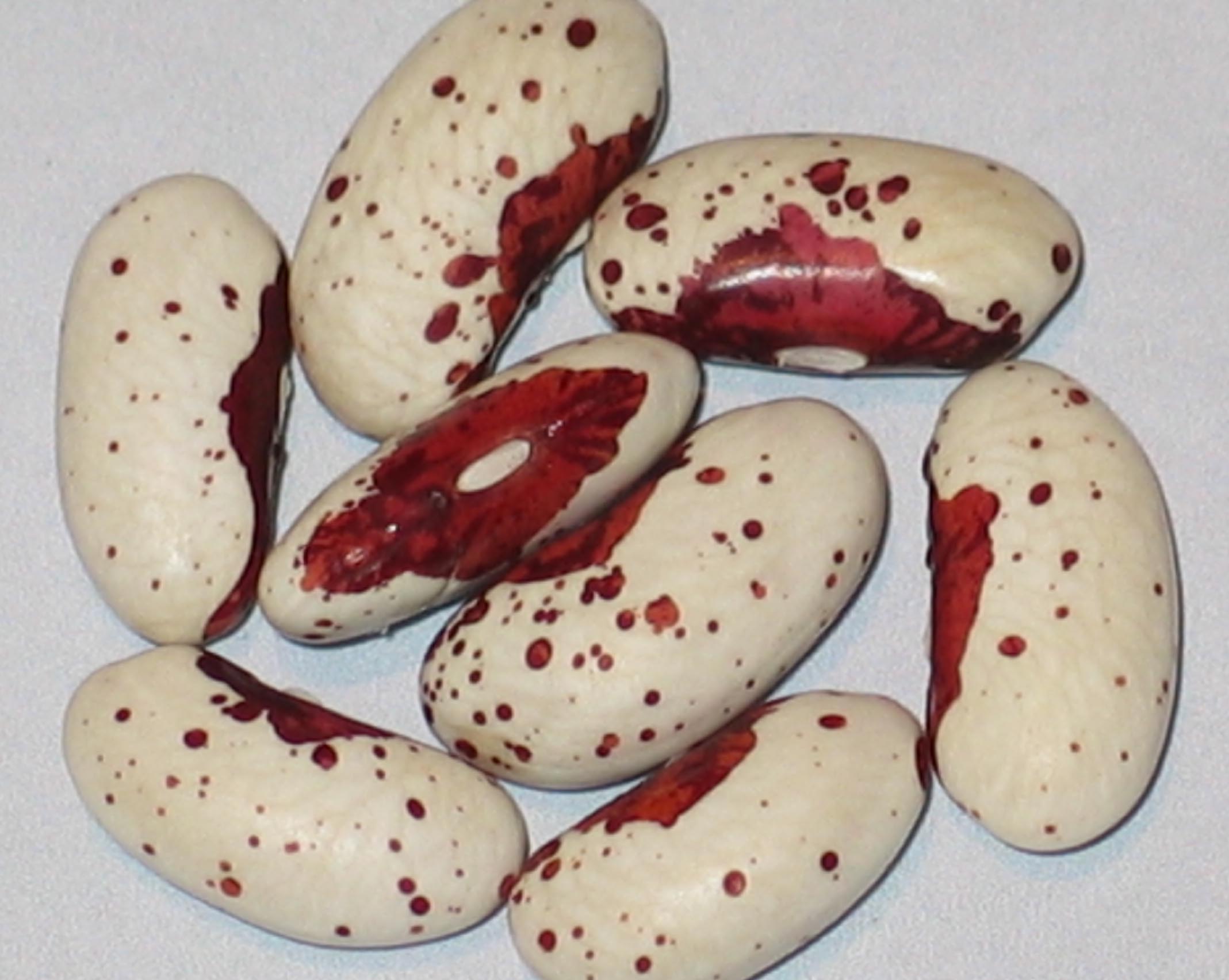
Great Lakes Special
Packet Size 25 Seeds $5.00
Great Lakes Special is a bush dry bean variety characterized by its large, wide, and productive plants that reach about 22 inches in height, yielding dry pods in approximately 90 days. Developed and named by the late Robert Lobitz of Paynesville, Minnesota, in the late 1990s for the Seed Savers Exchange yearbook, this variety is particularly noted for producing some of the most beautiful seeds seen among beans, making it a standout choice for gardeners.

Greek Cypriot
Packet Size 20 seeds $5.00
The Greek Cypriot Pole Snap bean is indeed an heirloom variety with a somewhat obscure history. It has been passed along through gardening circles, including from Canadian gardener Annette Barley of Nanaimo, B.C., who shared it with others due to its resilience and productivity. This bean is notable for its ability to grow as a pole variety, requiring support as it climbs, and produces tender, flavorful pods that are perfect for fresh eating or cooking. The unique lineage and connection to specific gardeners make it a cherished variety among those who appreciate heirloom plants and their stories.
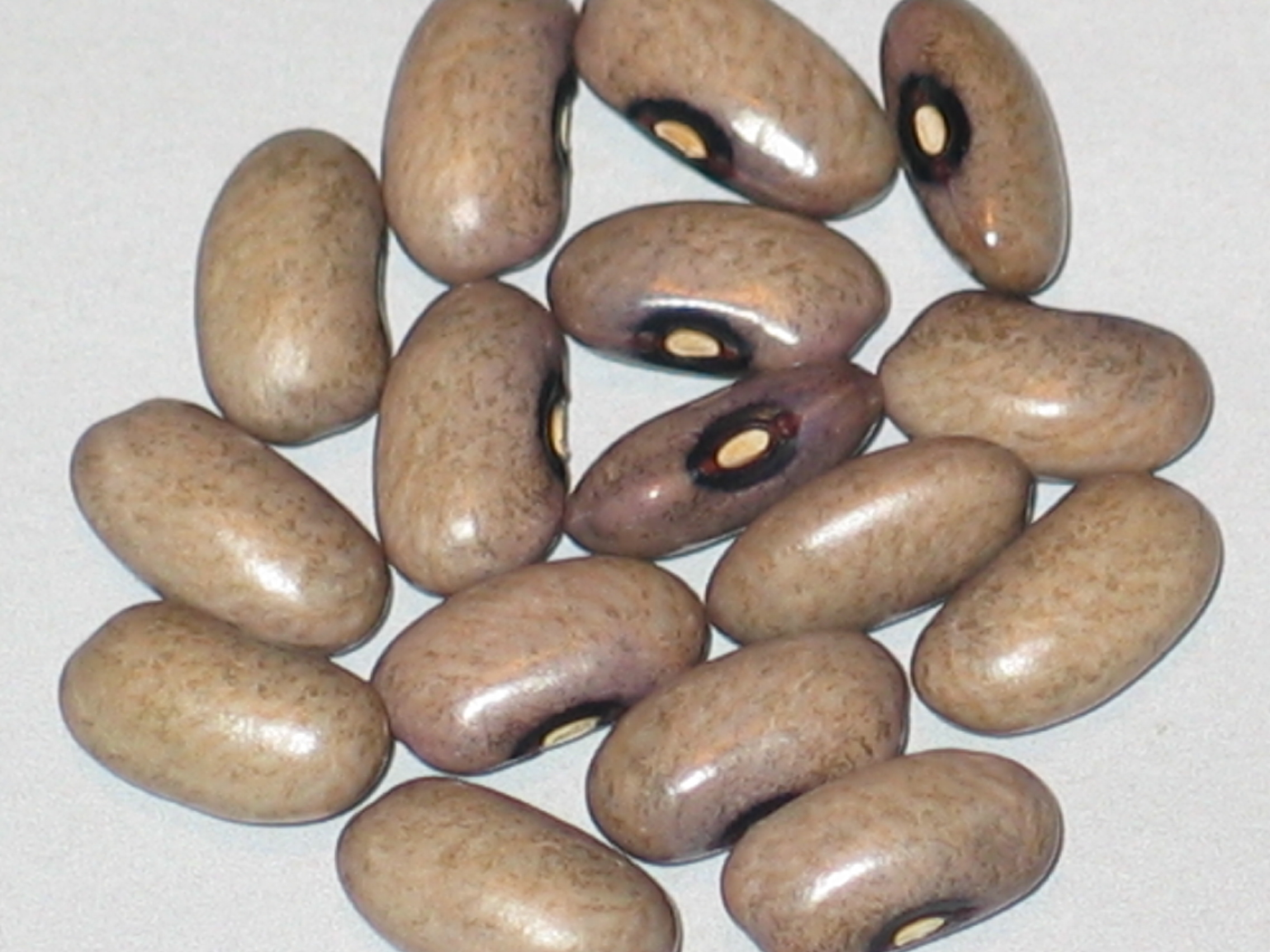
Green Savage
Packet Size 25 Seeds $5.00
Green Savage is a pole green snap bean developed by the Louisiana Agricultural Experiment Station. Released by Reuter Seed Co. in 1949. It results from a cross between Savage Wonder and Canfreezer, it exhibits exceptional traits such as stringlessness, high yields, and straight pod formation. It's rust resistance makes it hugely resilient, that has allowed it to perform well in southern breeding grounds. Also in northern climates, as seen in your northern Illinois garden and Ontario, Canada. A combination of quality and adaptability has made the Green Savage a favorite of gardeners seeking reliable and productive bean varieties.
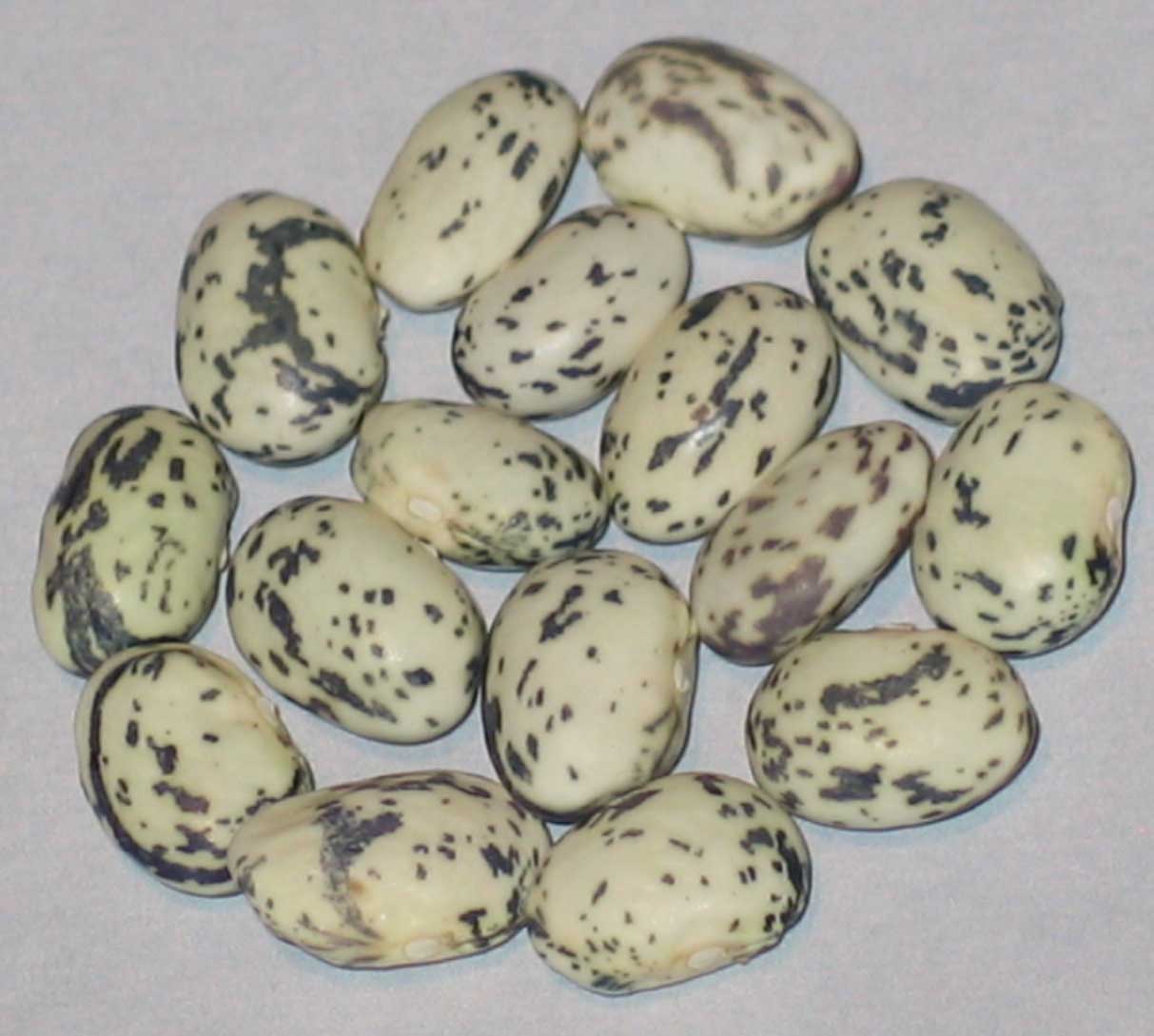
Hallados Grandos
Packet Size 25 Seeds $5.00
Hallados Grandos bean is a pole dry variety that is believed to have Spanish origins, possibly introduced to the U.S. by world traveler Joseph Simcox, who brought it back from his journeys to Spain. Acquired from a grower in New York State in 2019, this bean is known for its productivity, makeing it an appealing choice for gardeners looking to cultivate high-yielding dry beans. Its intriguing history and robustness contribute to the charm of growing heirloom varieties that connect different cultures and gardening traditions.
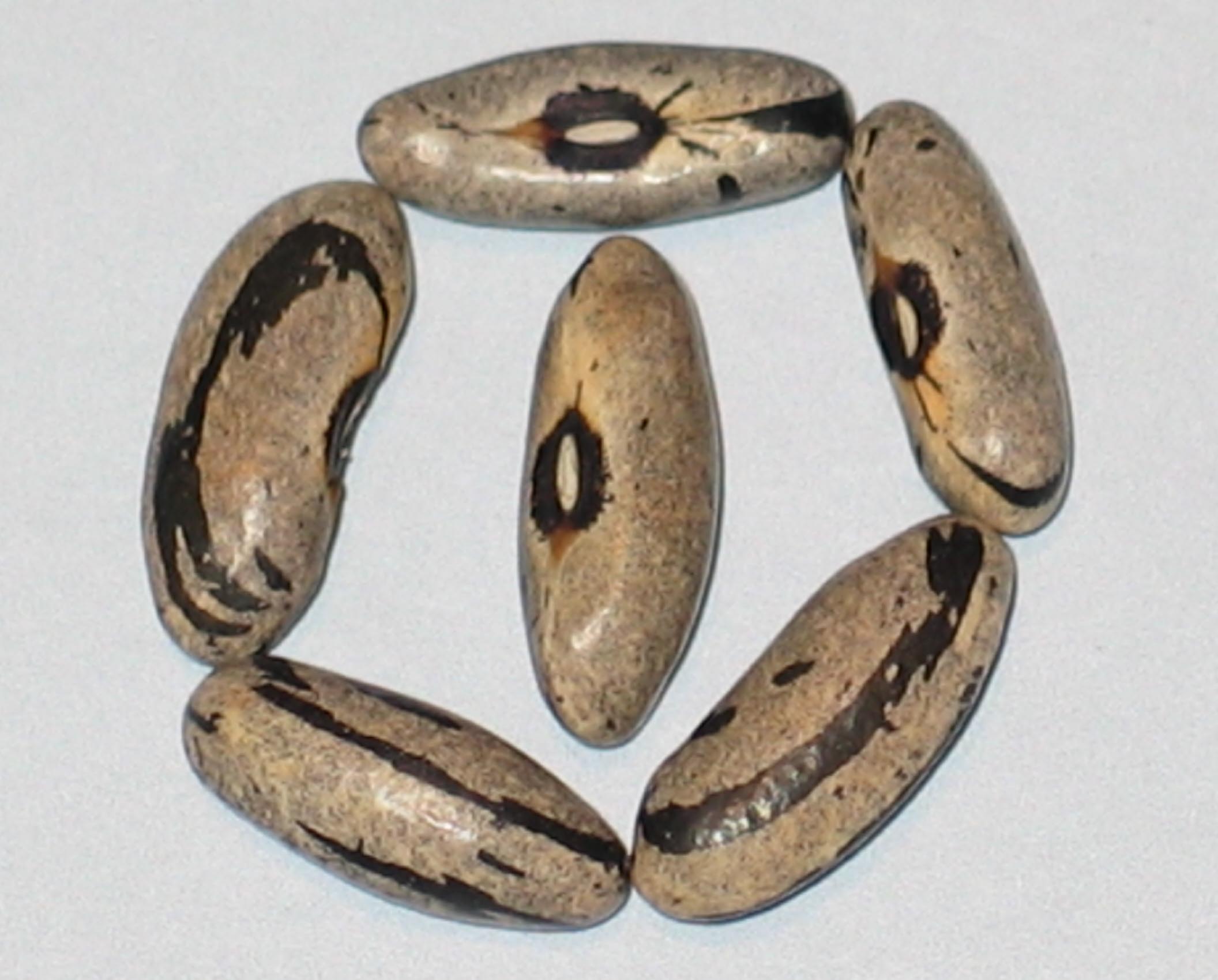
Hanna Hank
Packet Size 25 Seeds $5.00
The Hanna Hank Pole Snap bean takes about 70 to 80 days to produce its first snaps and has an interesting heritage, as it was obtained from a member of Seeds Of Diversity Canada in London, Ontario, who sourced it from Hanna Hank's family. Its appearance closely resembles the Ramshorn bean, which John Withee featured in his Wanigan catalog and that I had grown in the early 1980s. This possible connection not only highlights the lineage of the bean but also reflects the importance of preserving diverse seed heritage within gardening communities.

Harmony
Packet Size 25 Seeds $5.00
Harmony is a bush dry variety of cranberry-type beans that I had stabilized in 2015 from a packet of outcrossed beans received from Will Bonsall of the Scattered Seed Project in Industry, Maine. In 2020, I named this bean after the small rural town of Harmony, Illinois, situated in McHenry County, which reflects both a connection to its origins and a tribute to the community. This bean not only represents agricultural heritage but also the personal journey of seed preservation and naming inspired by local history.
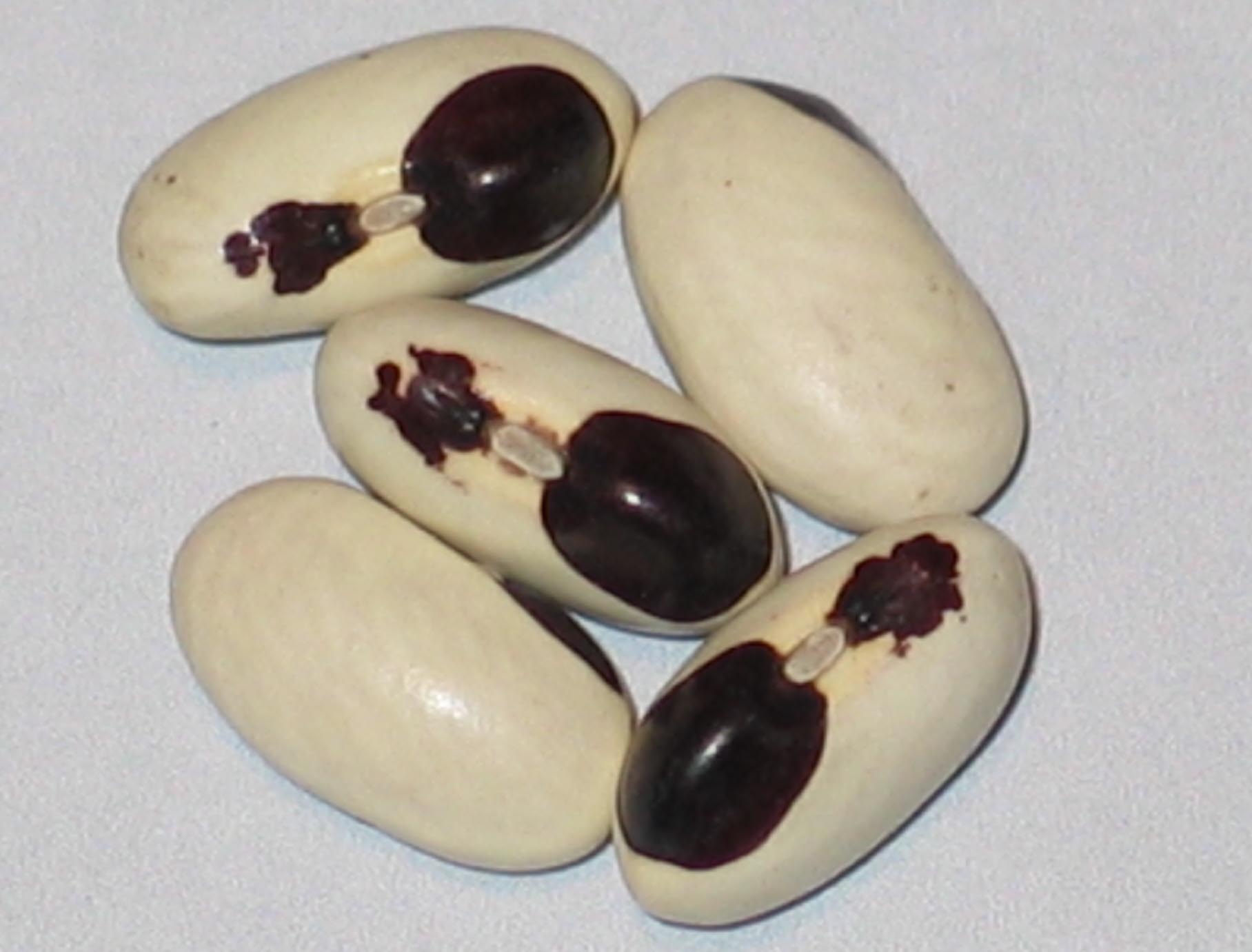
Hashuli
Packet Size 15-20 Seeds $5.00
The Hashuli bean is a pole dry variety that was acquired by American seed and plant collector Joseph Simcox at a market in Tbilisi, Georgia. According to the seller, this unique bean originates from a village named Hashuli, giving it its distinctive name. Notably, this bean is an uncommon type even within Georgia, making it a valuable addition to collections focused on rare and diverse plants from global origins.
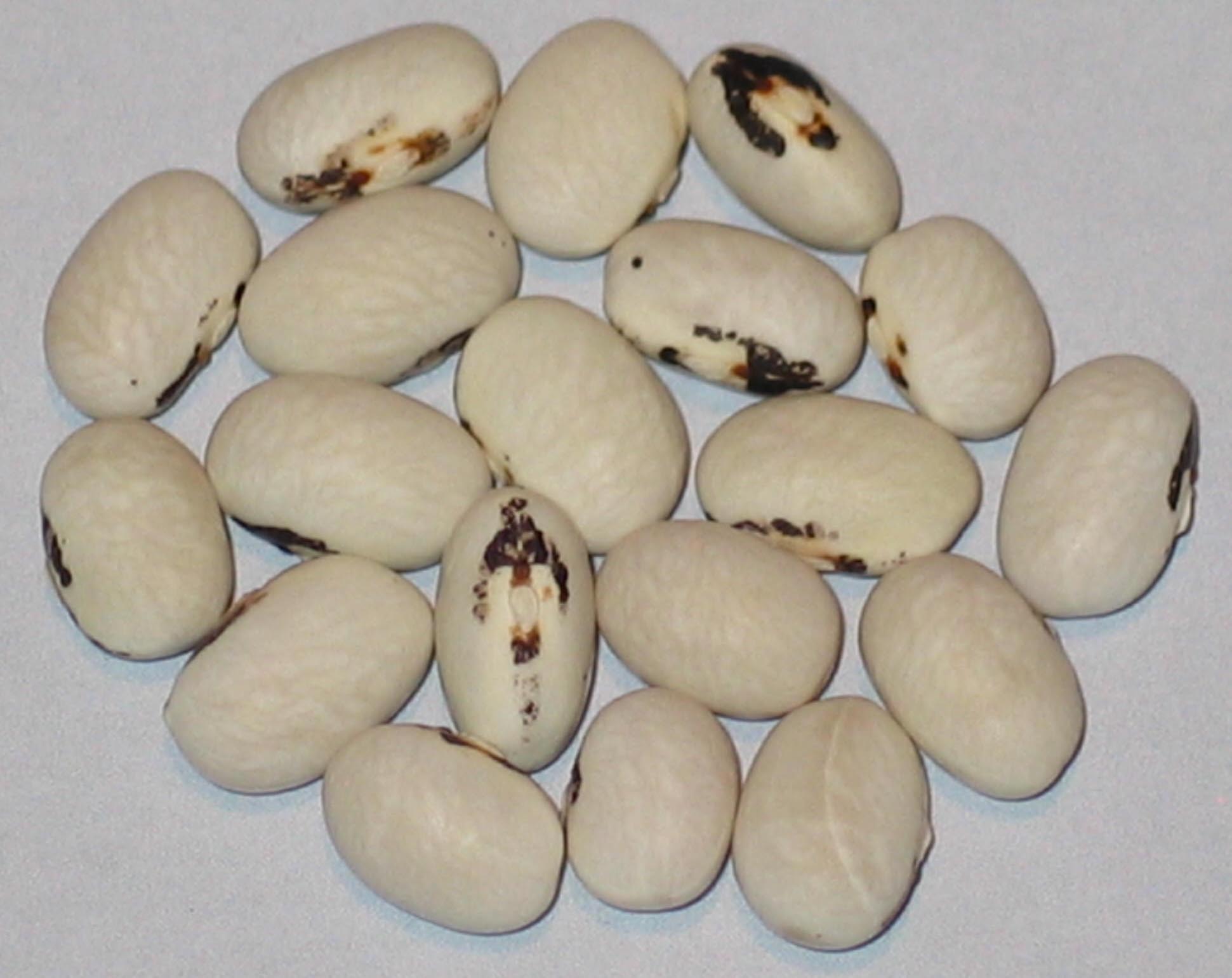
Hawick
Packet Size 30 Seeds $5.00
Bush Dry. Compact plants 14 inches tall. First dry pods in about 90 days. Blossom white. Very productive plants that produce 4.5 inch pods. An original bean named and introduced through the Seed Savers Exchange yearbook by the late Robert Lobitz of Paynesville, Minnesota. He was an early member of the Seed Savers Exchange since the early 1980's. The bean does appear in the 2001 SSE yearbook. Named after the village of Hawick, Minnesota located southwest of Paynesville in Kandiyohi county along state highway 23.
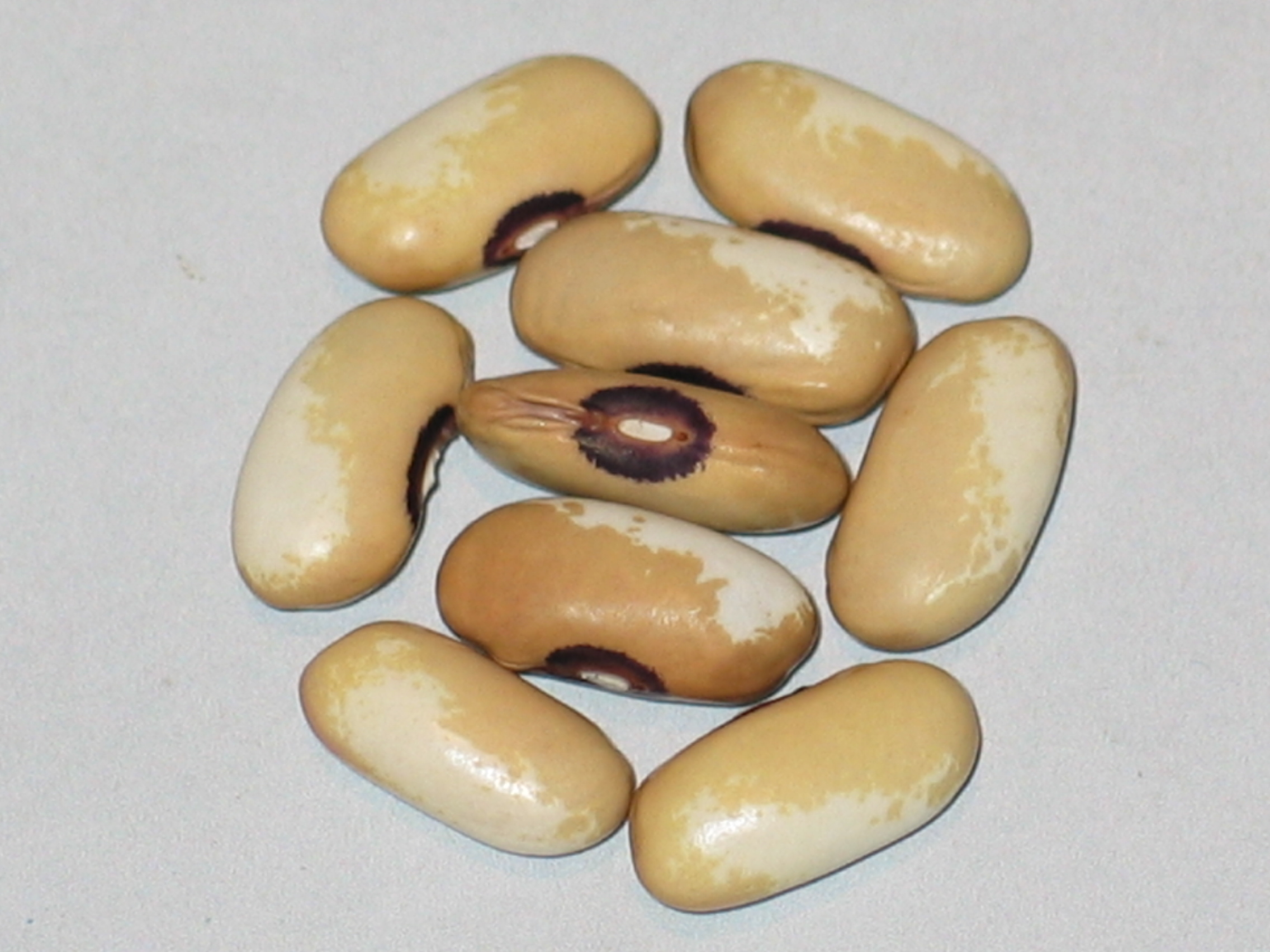
Hebron
Packet Size 25 Seeds $5.00
Hebron is a bush dry bean variety named after the village of Hebron, Illinois, situated along Illinois Route 47 in McHenry county. After five years of careful observation, I had determined it to be stable enough to share with fellow bean enthusiasts. This variety is a distant relative of the White Robin bean, developed by Robert Lobitz, highlighting my passion for cultivating and preserving unique new bean varieties.
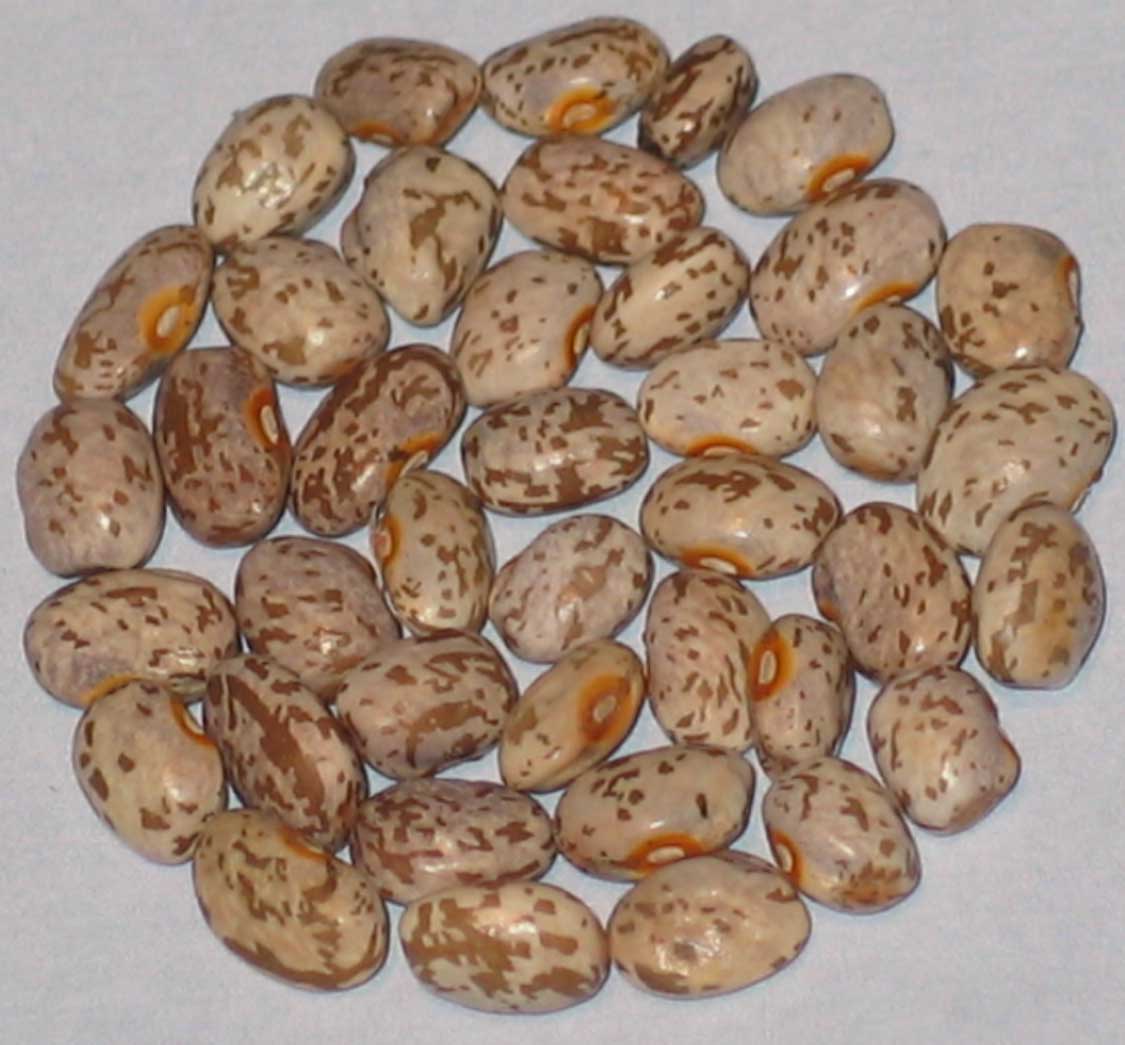
Headrick Greasy Cutshort
Packet Size 30 Seeds $5.00
The Headrick Greasy Cutshort, a pole variety of greasy bean, is noted for its high productivity and green pods that are best enjoyed when plump with beans. This unique strain was originally discovered in the floor cracks of an old house in Harlan County, Kentucky, underscoring its rich heritage and local significance.
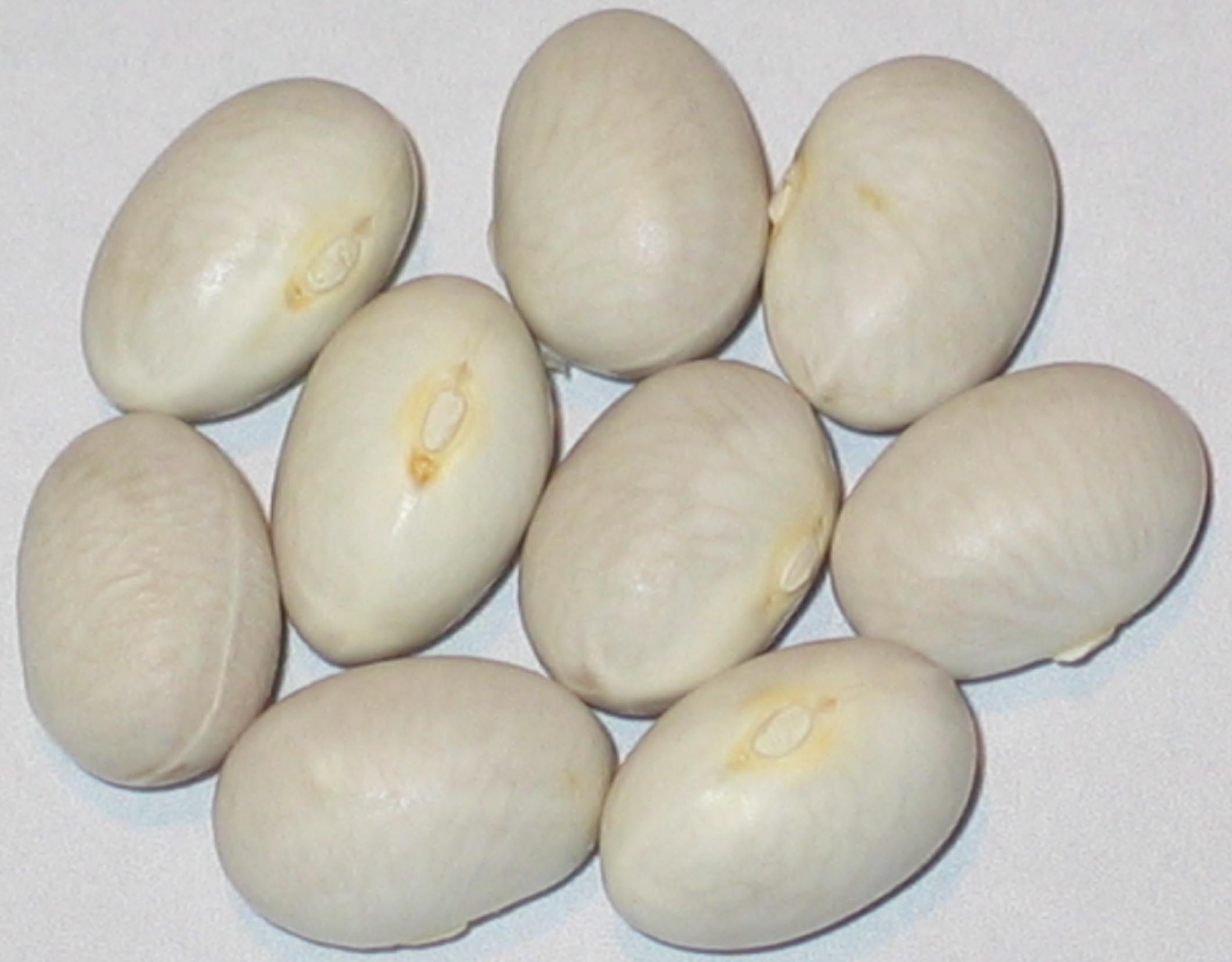
Heiling's Bean
Packet Size 25 Seeds $5.00
The Heilings bean is a bush dry variety that holds special significance for me, first seen during a visit to my brother's house in Browerville, Minnesota, in October 1978. Originally grown in their garden and obtained from a neighbor named Kate Heiling, who could not recall its name, I decided to name it Heiling's Bean. While I've encountered other round white beans of similar size, this variety consistently appears slightly larger in my mind, making it a standout through my journey of collection.
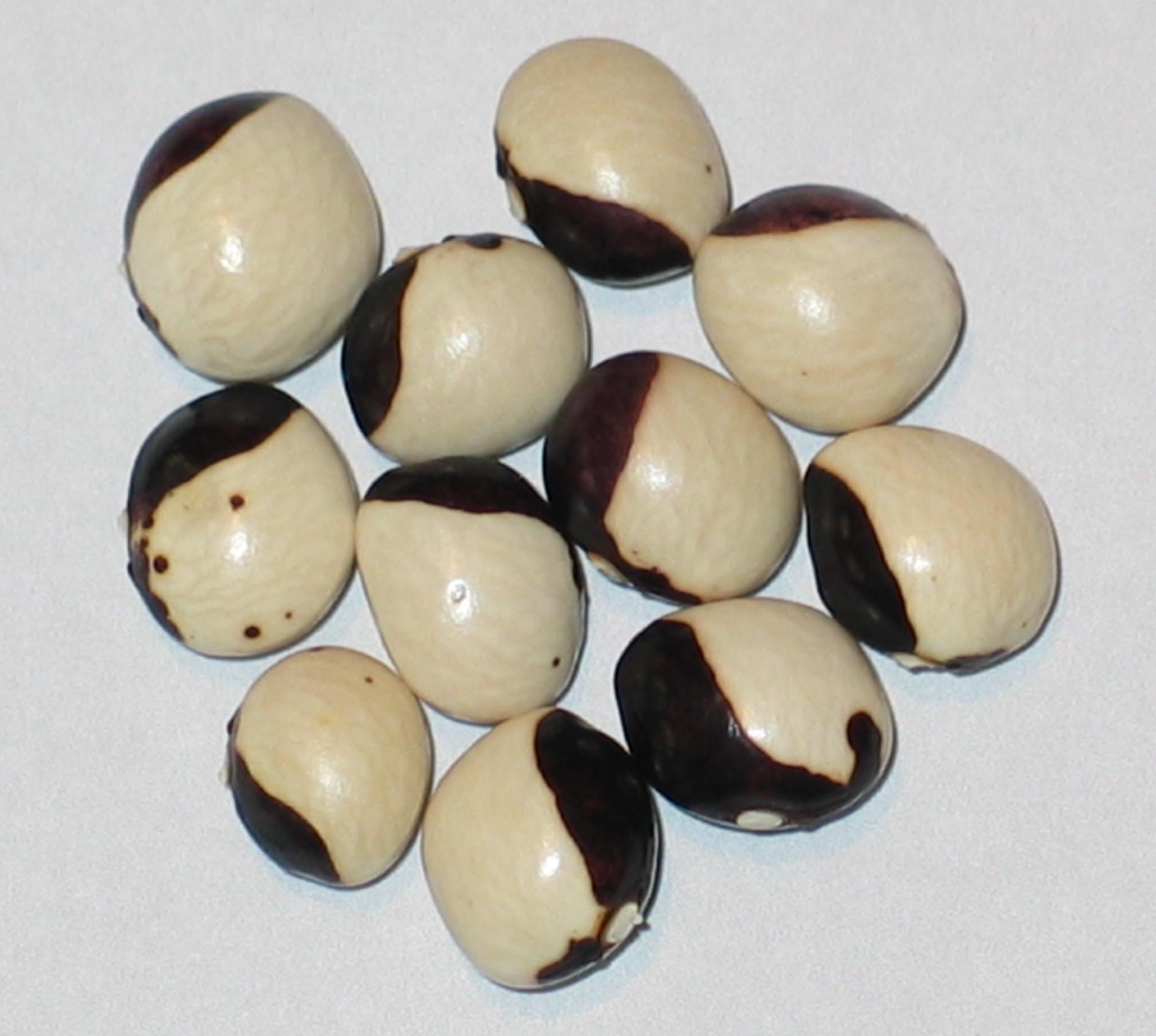
Hemelvaartboontje
Packet Size 20 Seeds $5.00
Hemelvaartboontje, also known as the Ascension Bean, is a traditional Dutch bean variety primarily cultivated in the Netherlands. "Hemelvaart" translates in English to "Feast of the Ascension", and this bean was named in honour of the bodily ascension of Jesus into Heaven. It's full name also translates to "Ascension Bean" in English, which refers to its association with the Christian holiday of Ascension Day, celebrated 40 days after Easter. This variety is known for its distinctive, flavorful characteristics and is often used in regional dishes. Historically, it has been appreciated not only for its taste but also for its role in Dutch agricultural heritage.
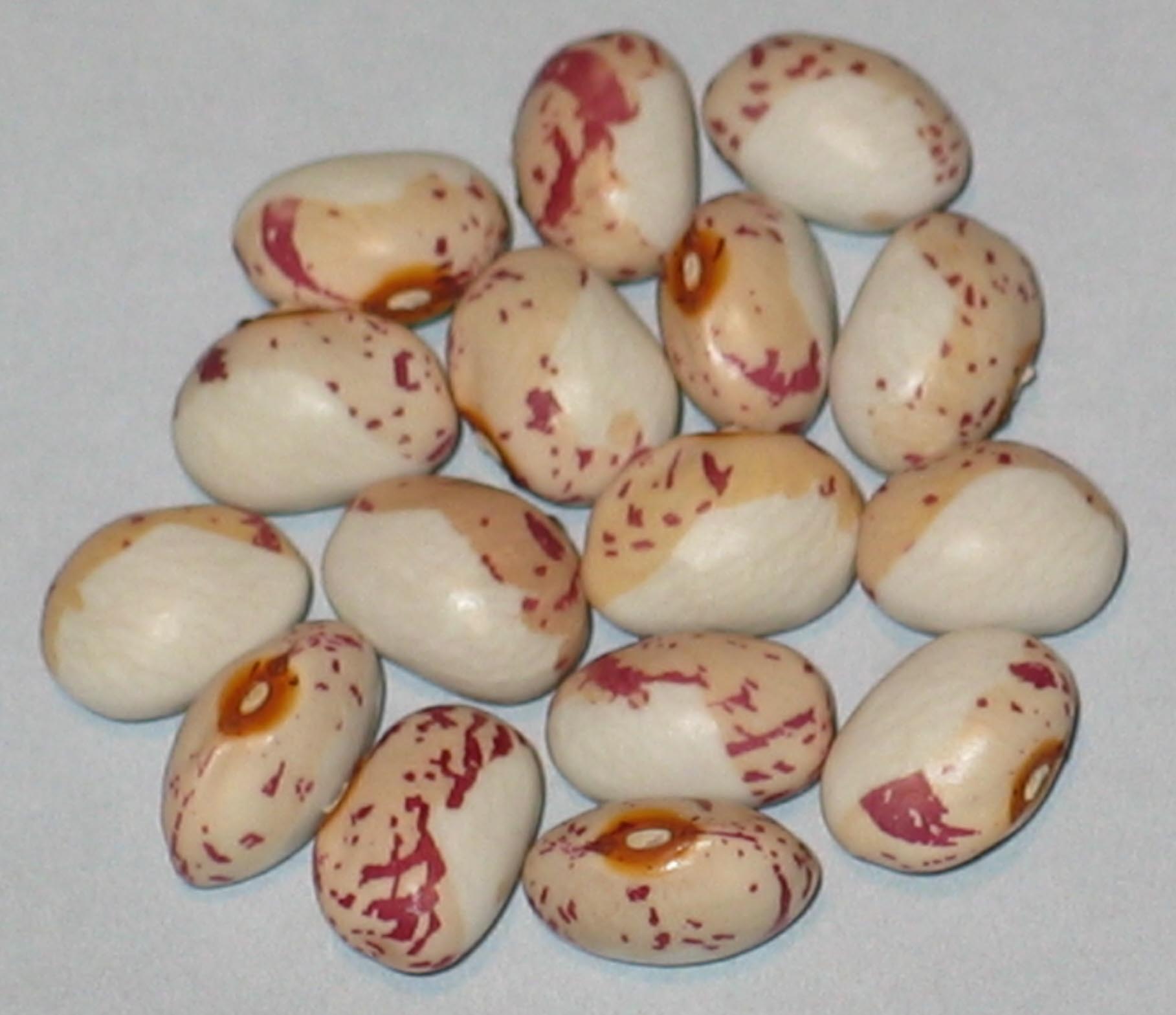
Hiawatha
Packet Size 25 Seeds $5.00
A pole dry bean, Hiawatha matures in just 93 days, making it an early variety for pole beans. Notably productive, this bean originated as an outcross and was named by me after receiving seeds in a package from Will Bonsall's renowned "Scattered Seed Project" in 2015. Hiawatha’s seed mother, the Norridgewock, features a rounded white seed adorned with a prominent red eye patch. This versatile bean is well-suited for soups and baked bean dishes, making it a flavorful addition to any meal.
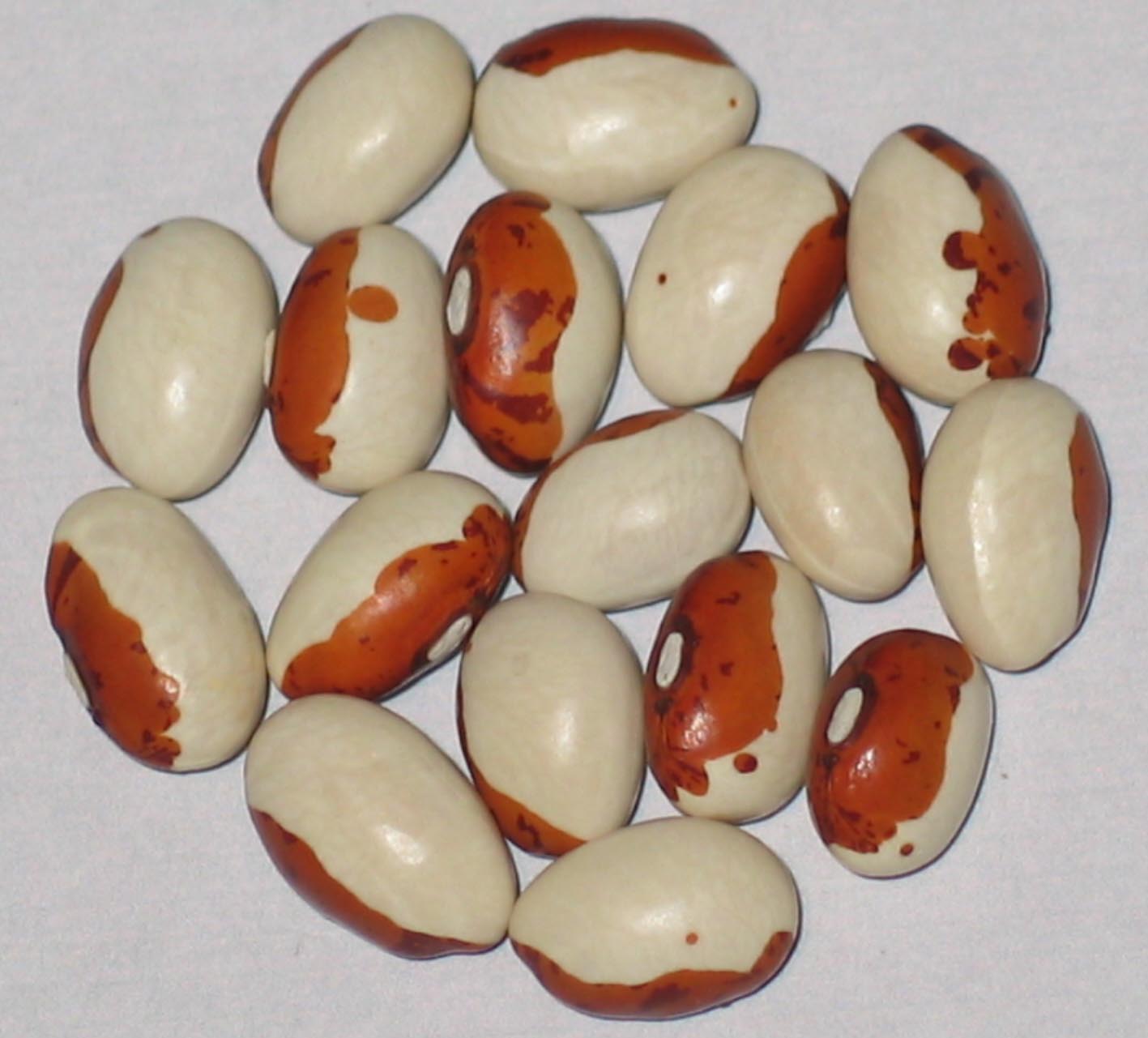
Hidatsa Shield Figure
Packet Size 25 Seeds $5.00
The Hidatsa Shield Figure is a pole dry bean variety known for its impressive growth, with vines reaching 8 to 9 feet tall and producing abundant yields. It typically matures in about 90 days, yielding large beans. Originating from the Hidatsa people of the Missouri River Valley in North Dakota, this bean carries a rich cultural heritage and is celebrated for its robust flavor, making it a favorite in soups, stews, and a variety of culinary dishes. It's adaptability also makes it popular among gardeners, particularly in regions with shorter growing seasons.

Italian
Packet Size 25 Seeds $5.00
This Italian bean is a pole snap variety known for its early productivity and tender, stringless green pods, though its exact origin remains unknown. Taking approximately 95 days to mature dry seed, it has been a favorite for over a decade among an Iowa grower friend, praised for its consistent performance and excellent flavor in various dishes. This versatile bean is ideal for fresh eating, adding a delightful crunch to salads and stir-fries.

Holy
Packet Size 25 Seeds $5.00
Pole/Snap/Dry? The seedcoat is very similar to Leslie Tenderpod. This climber comes to me via the Central Tree Crops Research Trust in New Zealand from their New Zealand Bean Project. Thanks to Mark Christensen, Research Director of the Trust for being a willing bean swapper. Possibly like Selugia this bean may have been brought back to New Zealand with the returning servicemen at the end of the second world war.
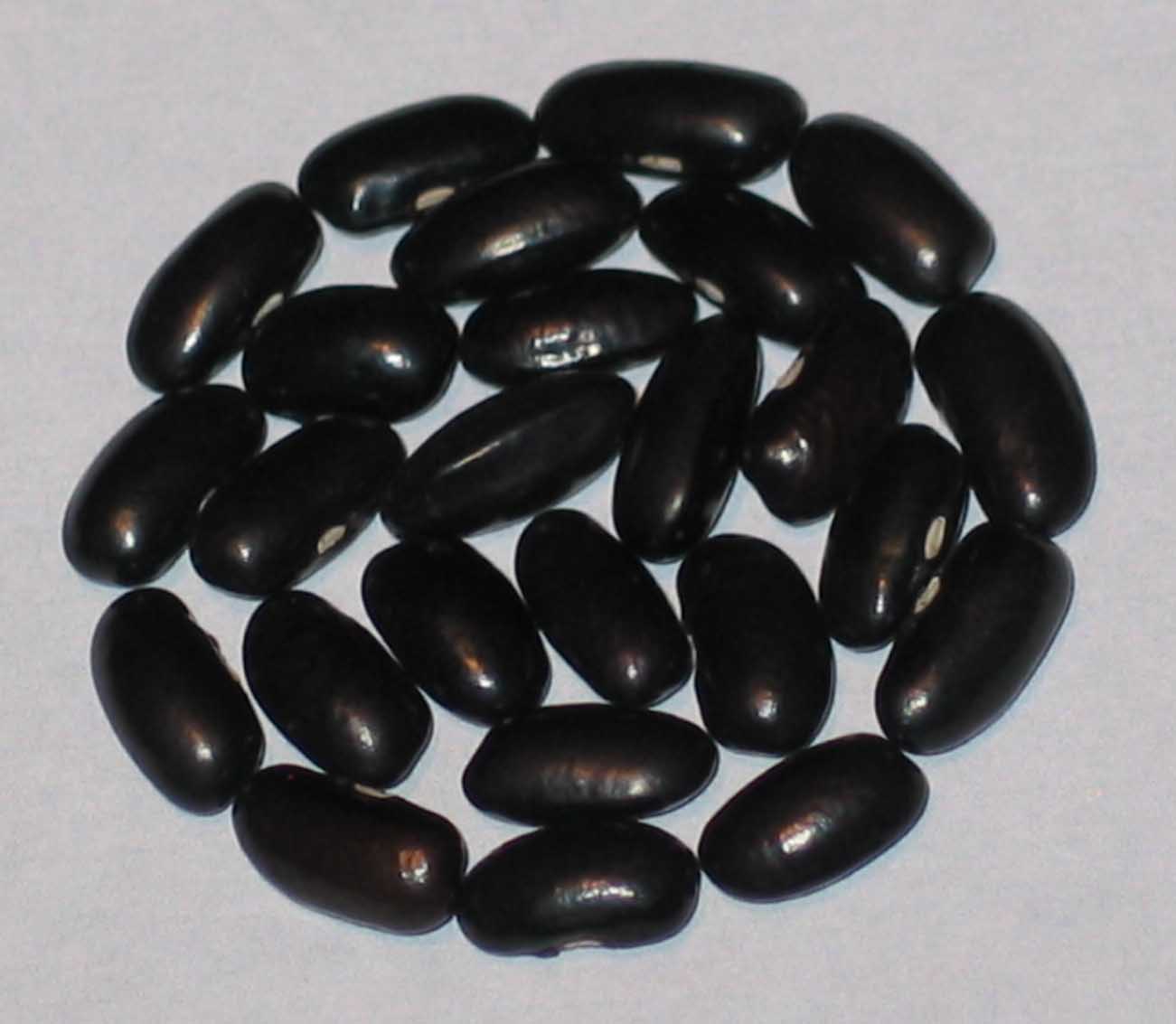
Hopi Black
Packet Size 44 Seeds $5.00
The Hopi Black bean is a drought-resistant pole dry variety native to the American Southwest, characterized by its productive 5-foot vines and small black seeds. Known for their culinary versatility, these small beans cook quickly and are flavorful, often outperforming larger-seeded varieties in total yield. Additionally, the seeds can be used for dye, adding to their cultural significance and utility for those living in arid climates, where they thrive without the need for additional watering.
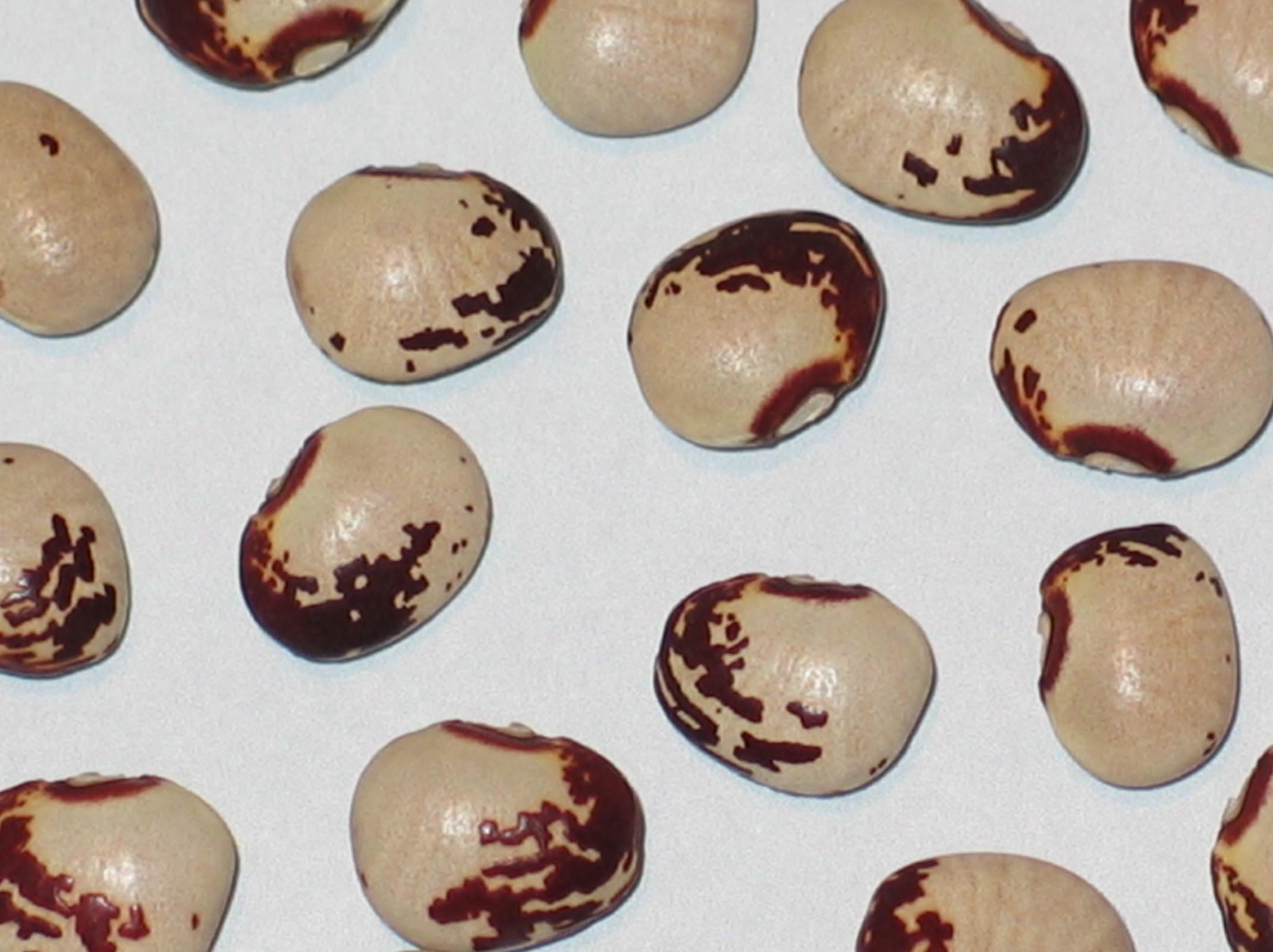
Horn Speckled
Packet Size 25 Seeds $5.00
Horn Speckled bean is a pole lima variety that takes about 110 days to produce its first dry seeds. With short pods that are not as flattened as typical lima beans, the seeds are rounded and somewhat plump. Known for its prolific pod production, this variety has a history of cultivation dating back to the 1980s and was acquired from a member of the Seed Savers Exchange (SSE), making it a unique and cherished addition to any garden.
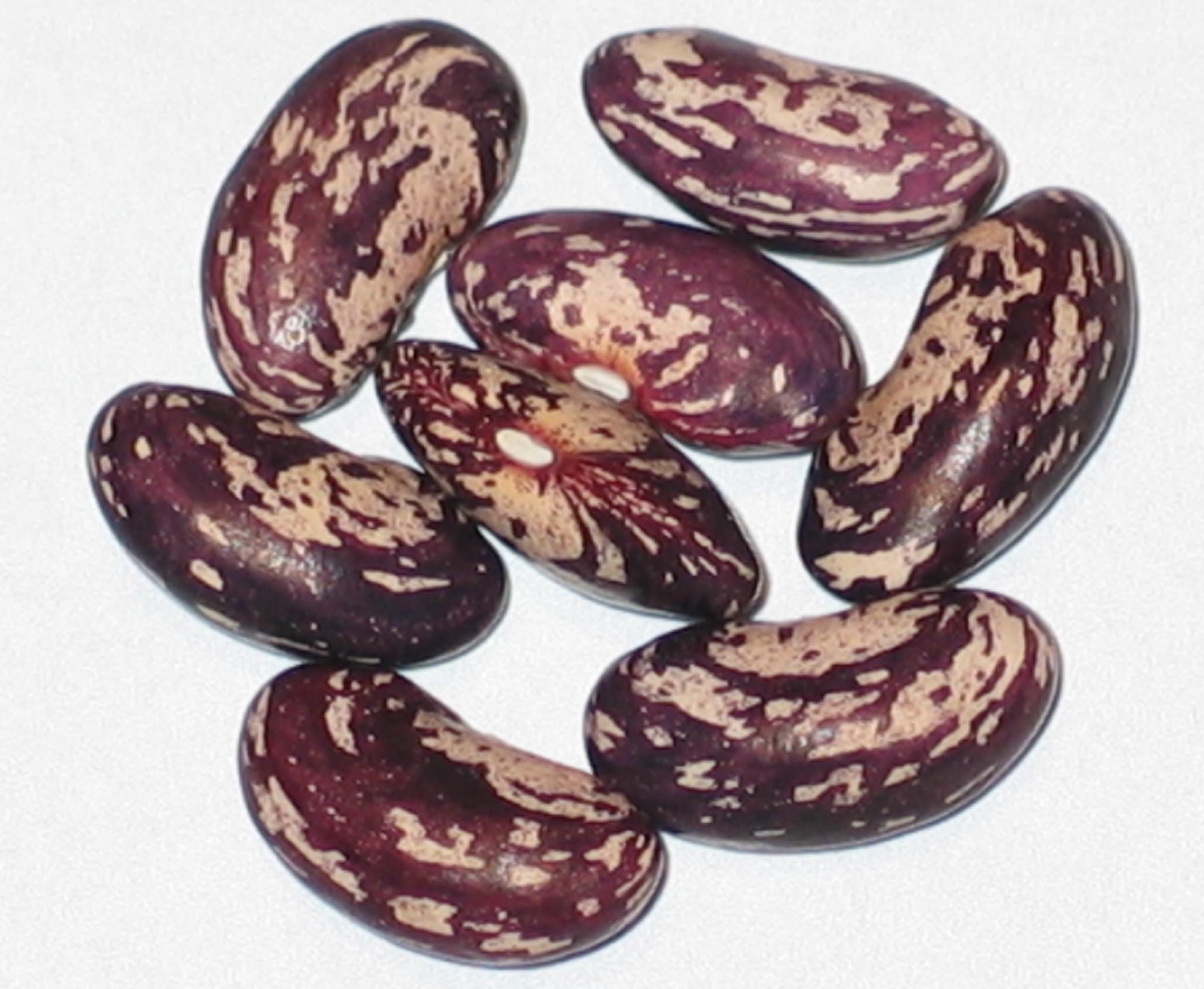
Horsehead
Packet Size 25 Seeds $5.00
Horsehead is a bush dry bean variety characterized by its white blossoms and a quick maturation time of over 80 days for dry seed production. These productive sprawling plants are drought-tolerant and feature round pods that are easy to hand shell, making them practical for gardeners. Originally acquired from the Henry Doubleday Research Association in the UK around 1980, which is now known as Garden Organic, this variety combines historical significance with agricultural resilience